Modern Milwaukee, shaped by a variety of ethnic traditions, boasts great places to eat, drink, and live well.
Our five-day experience in Milwaukee was organized and subsidized by Visit Milwaukee and its business partners mentioned herein. This post contains affiliate links and/or references to our advertisers. We may receive compensation when you click on or make a purchase using these links.
Modern Milwaukee is impacted by the legacy of 19th-century European immigrants, as well as others who came later, all seeking the American dream. Their cultural influence lives on in a vibrant mix of ways to eat, drink and live well in Wisconsin’s largest city.
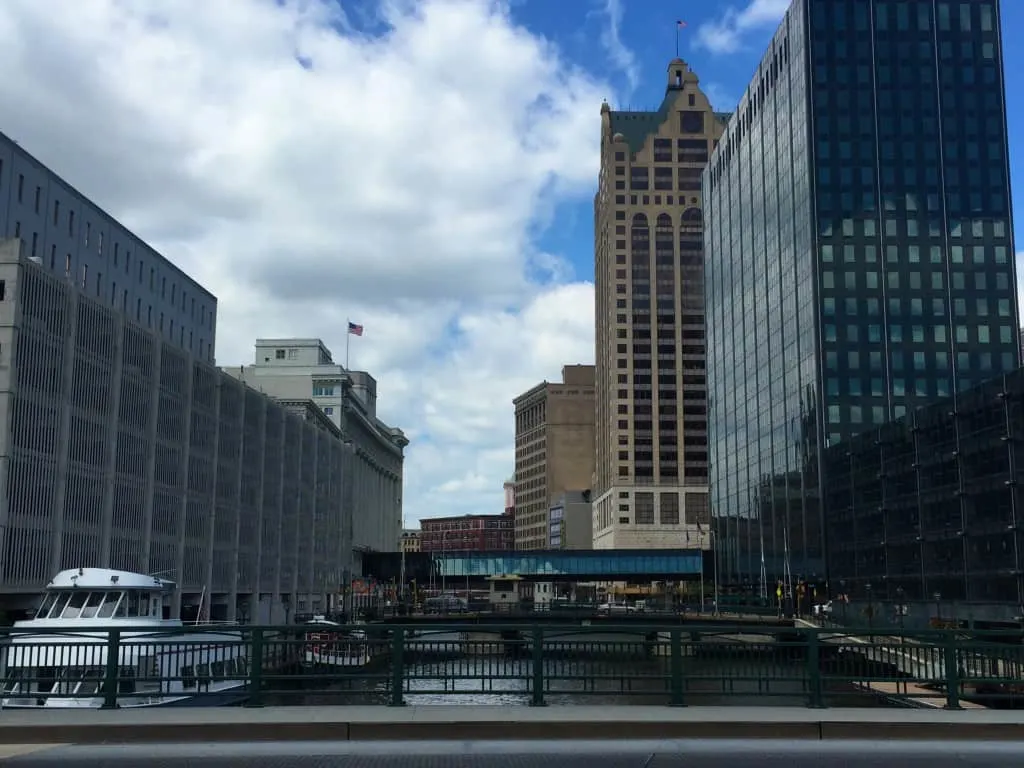
Modern Milwaukee Riverwalk
On a recent visit to Milwaukee, we had a chance to see first hand how waves of immigration shaped the city’s growth. Modern Milwaukee is descended from the communities of Germans, Poles and other immigrants who, by 1910, had distinguished it in a tie with New York as having the largest percentage of foreign-born residents in the United States.
My dear Children! I place these few lines in the Package containing my last Will and address them to you. . . You have all been good Children, and a great Comfort to me. My happiest thoughts are connected with you in the hope and belief that after I shall be called away, you will, all of you strive to be kind and good. . . – Frederick Pabst, founder of the Pabst Brewing Company, in a letter dated August 30, 1899
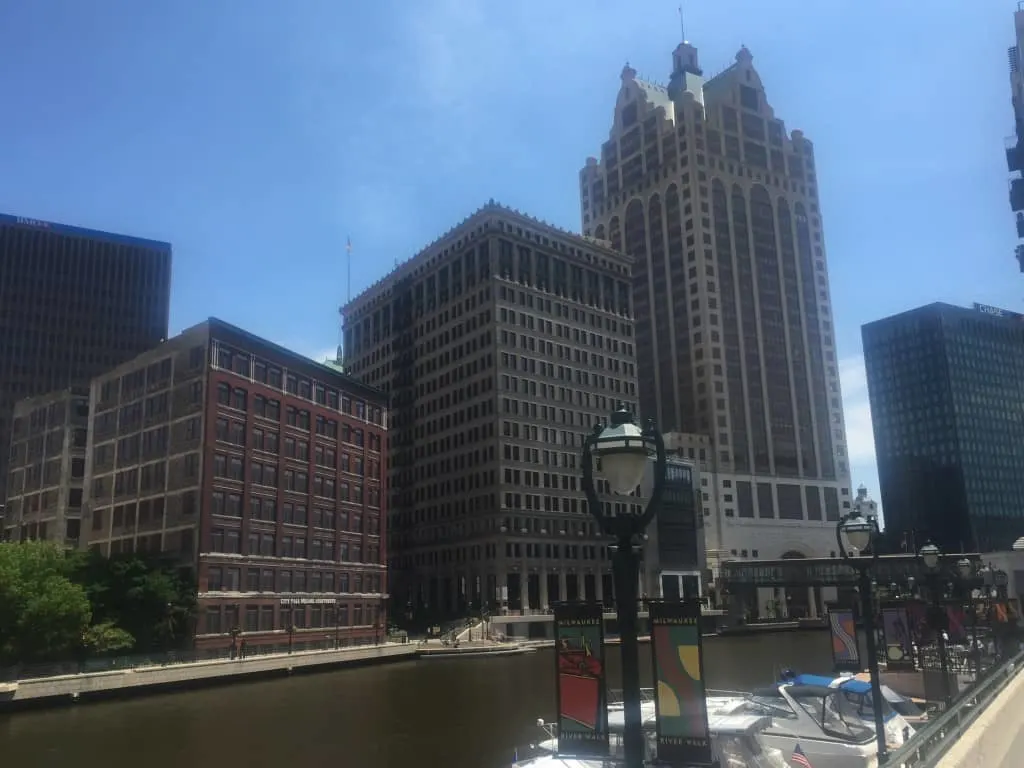
Modern Milwaukee skyscraper mimics traditional Old World architectural features
The strength of these ethnic and historic roots enabled Milwaukee to avoid the severe population declines other American cities experienced in the latter half of the 20th century. Modern Milwaukee’s rich historical legacy is present in revitalized communities and neighborhoods distinguished by vintage architecture, much of it rendered in the golden tones of its distinctive Cream City brick.
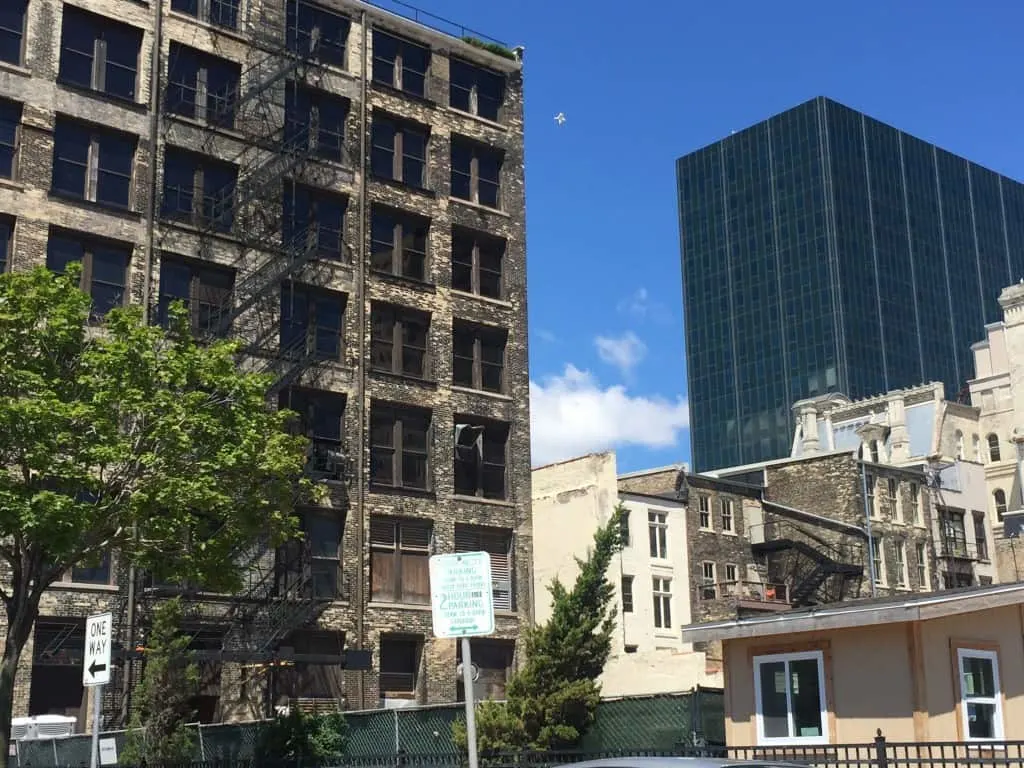
Architectural diversity in downtown Milwaukee. Cream City brick buildings and modern glass. Inferior bricks darkened with age, while higher quality product remained light in color.
At a variety of stops in the Historic Third Ward, Bay View, Brewer’s Hill, the East Side, and other locations throughout the city, Visit Milwaukee re-introduced us to a wonderful town. We found friendly sophistication, vibrant gastronomy, trendy and traditional watering holes, and thriving neighborhoods. If you haven’t visited Milwaukee lately, you should!
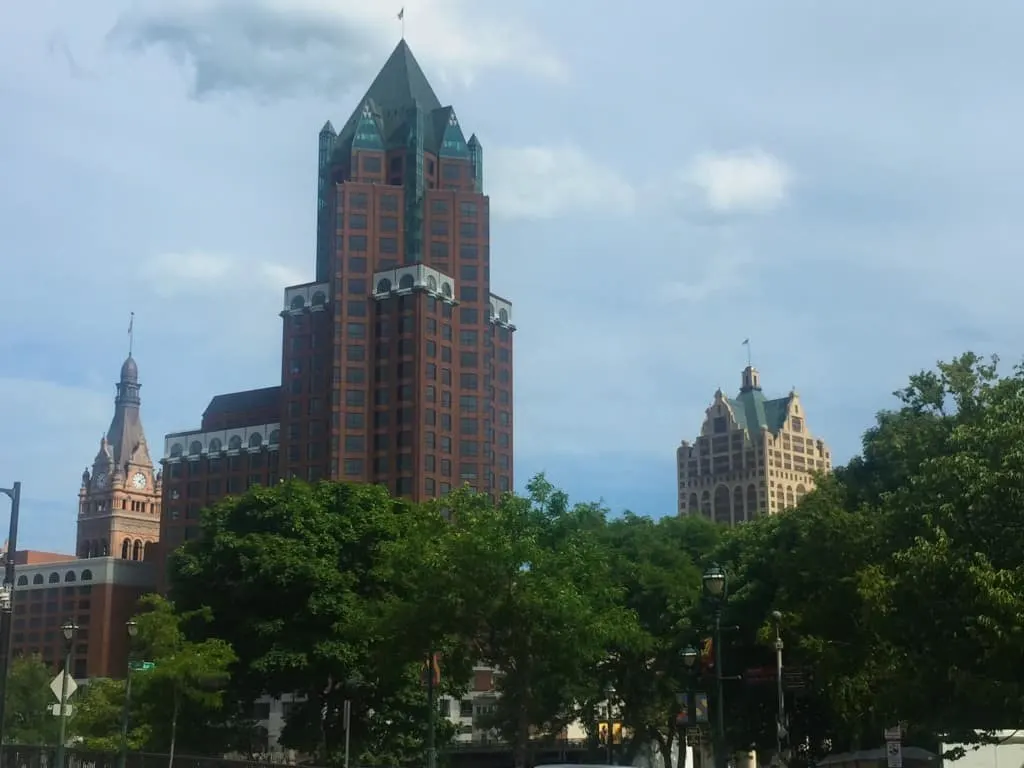
Skyline view of downtown
Modern Milwaukee Drinkers Love Beer, But It Doesn’t End There
If you’d visited Milwaukee several decades ago, as we last did, you might have deemed it solely a beer and bratwurst kind of place. Indeed, we heard “we take our drinking seriously here in Milwaukee” on more than one occasion during our five day visit, and any event centered around libations usually begins with beer. Likewise, bratwurst (and other old world style sausage) plays a big role in local cuisine. But there is creative innovation injecting new excitement into the traditional gastronomic scene here, too!
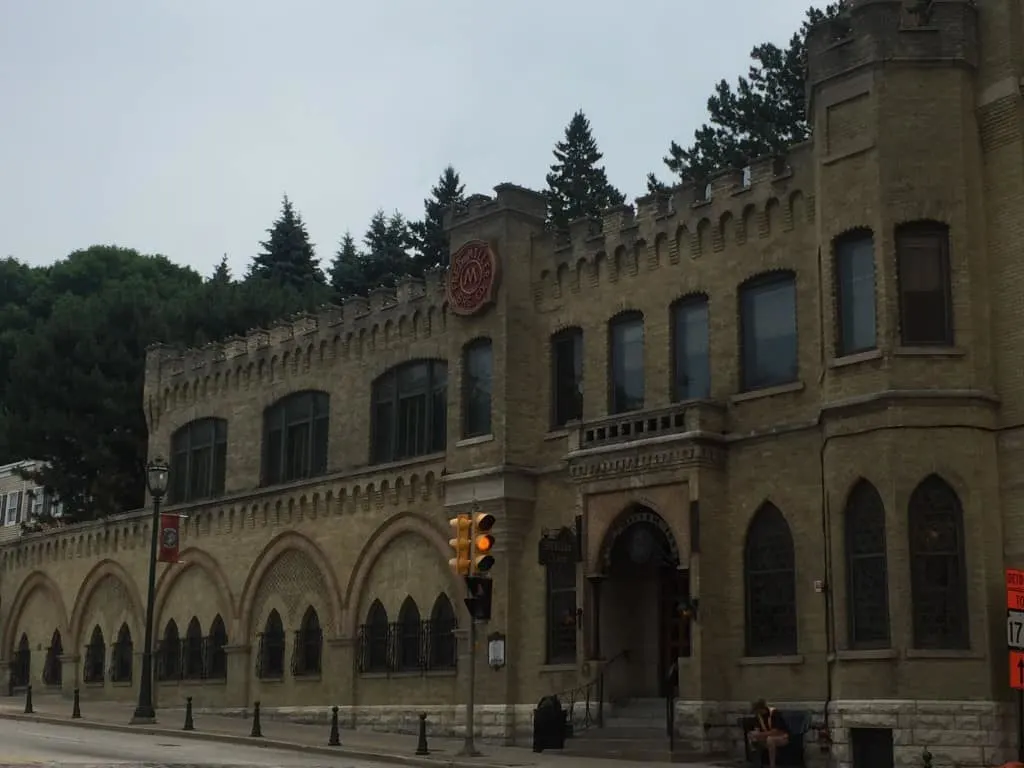
Vintage Miller Brewery Buildings adjacent to historic caves
Milwaukee was the largest beer producing city in the world at one time, boasting four of the world’s biggest breweries – all begun by German immigrants. The big names will immediately be familiar to most Americans: Pabst, Schlitz, Miller and Blatz. Today, Miller Brewing Company remains as one of Milwaukee’s largest employers.
- Touring the Miller Brewery
- The Miller girl in the moon logo
On our tour of the Miller Brewery, we learned the history of Miller High Life (the “Champagne of Beers”) and the brewery’s “Girl in the Moon” logo, both dating from the early 1900s. Today, Miller operates in the U.S. as a joint venture with Molson Coors, which also owns traditional brands such as Hamm’s and Icehouse. Its large-scale operation is highlighted in a fast-paced indoor and outdoor walking tour which ends with ice cold samples. Miller Brewery Visitor Center, 4251 W. State Street, Milwaukee, Tel. (414) 931-2150
“Try to keep the estate I leave you together, so far as you can, and make it productive of not only, of increase and Substance, but let it be a cause for mutual confidence and affection.” – Frederick Pabst letter.
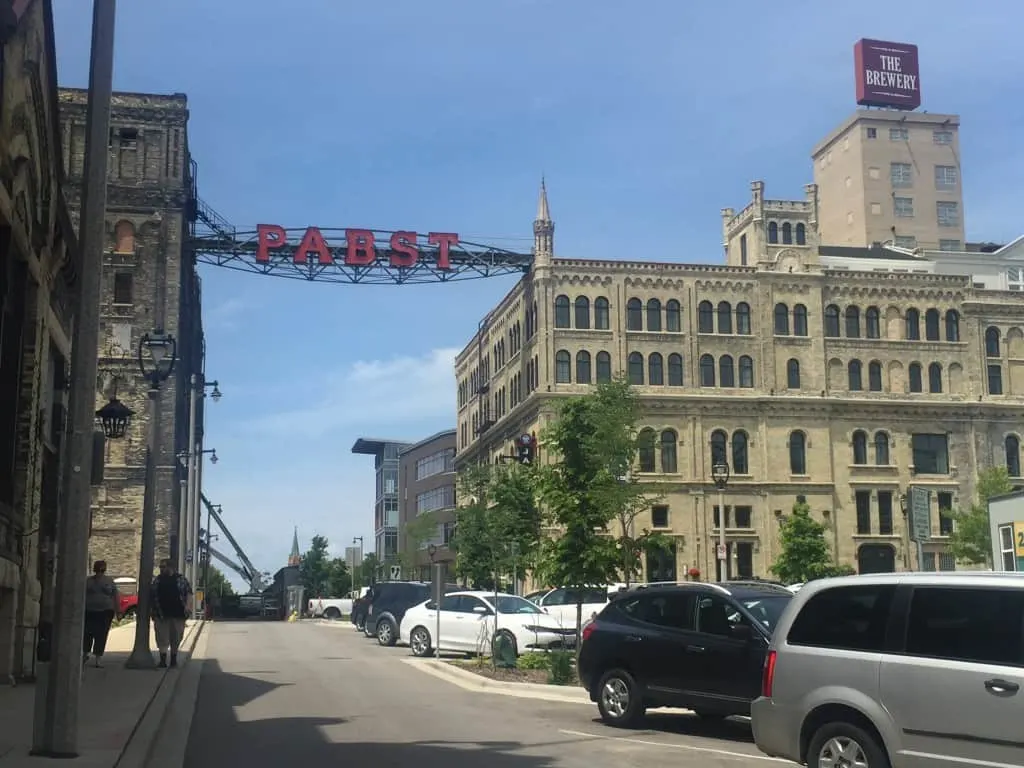
Historic Pabst Brewery
Another big name in Milwaukee beer history is Pabst. Emigrating from Saxony in 1848 with his parents, young Frederick Pabst signed on as a Lake Michigan steamer cabin-boy, working his way up to captain. Running his ship aground in 1863, he switched vocations, purchasing half of the Best Brewery from his father-in-law. Under Pabst’s guidance, the company’s annual production grew to 100,000 barrels. Pabst took the company public and became its corporate head within the space of ten years.
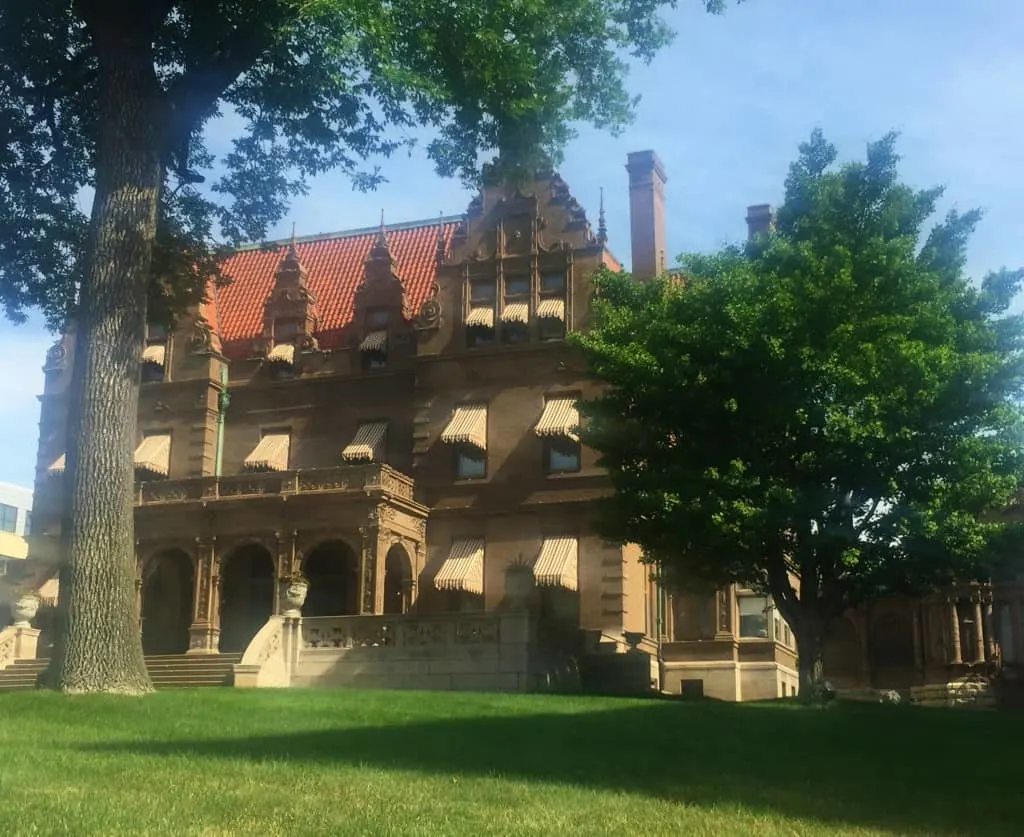
Pabst Mansion – Flemish Renaissance Style
In the 1890s, Captain Pabst commissioned several buildings to be constructed in the Flemish and German Renaissance Revival styles, which reminded him so much of the buildings from his European childhood. His personal residence, The Pabst Mansion which still stands at 2000 W. Wisconsin Avenue, was saved from the wrecking ball at the eleventh hour by a preservation group.
The mansion has 14 fireplaces, with an innovative central steam heating system which uses wooden ductwork and a gravity blower. Much of the art currently in the house is on permanent loan from the Blatz collection, amassed by the descendant of another Milwaukee brew scion.
“Be generous and unselfish to each other in Case of need and above all, be honest and noble, in all your dealings, not only with each other, but with the World.” – Frederick Pabst letter.
Pabst was a community leader and philanthropist, organizing the Wisconsin National Bank, developing a lakeshore amusement resort which could host 10,000 daily visitors, commissioning a performance theater which is still in use today, and raising champion French Percheron horses at two stock farms in Wisconsin.
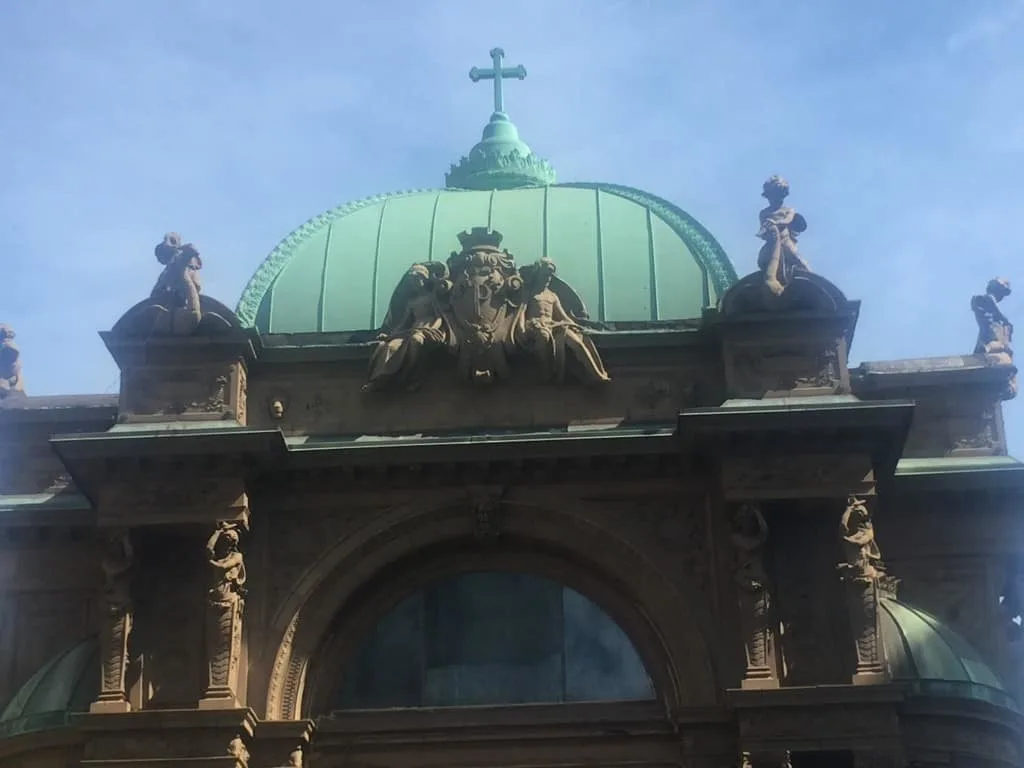
Domed pavilion first built for the World’s Fair, later used as a chapel by the Archdiocese
During our visit, we learned that while the Pabst family only lived at the mansion from 1892-1908, it was subsequently well-maintained by the Archdiocese of Milwaukee, which owned and used it as the Archbishop’s residence until 1975. An extra wing added to the mansion is actually a copper-domed Pavilion designed for the Chicago World’s Fair in 1893 and converted for use as a chapel. The Pabst Mansion, (414) 931-0808 ext. 110 for tour information.
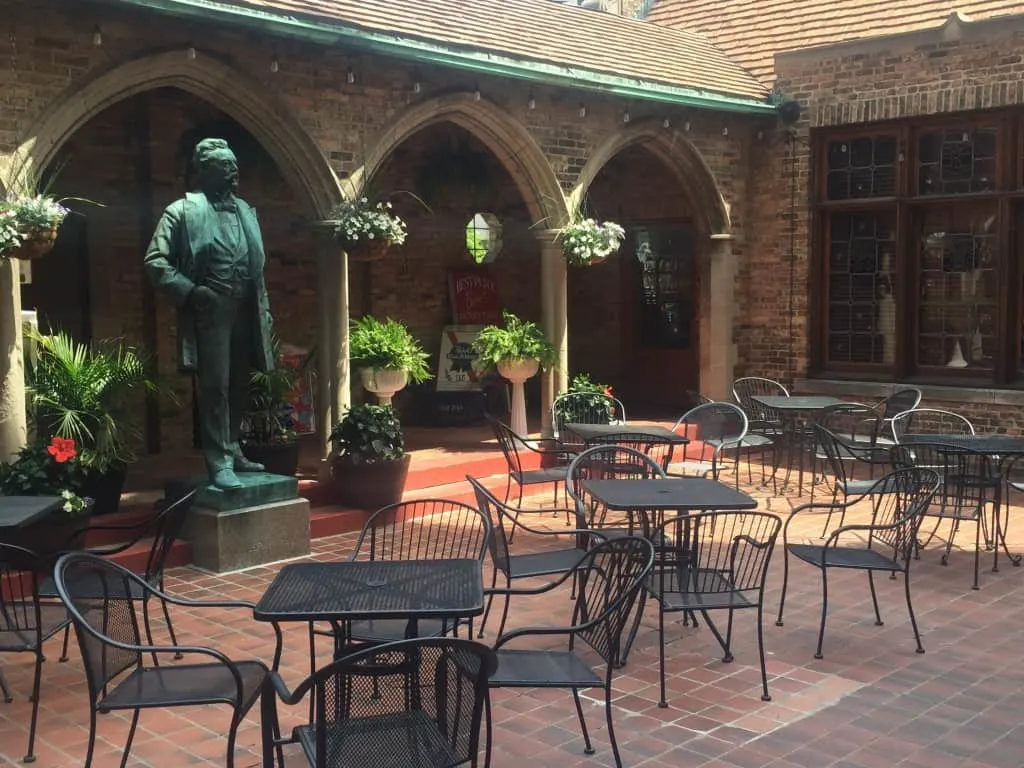
Captain Pabst stands in the Old World inspired courtyard at Best Place
You can also tour historic Pabst Brewery buildings dating from 1880 at Best Place, 901 W. Juneau Avenue, (262) 863-3737. See Captain Pabst’s original office, learn the brewery’s history, and soak up the Old World atmosphere in one of the original banquet halls or the friendly tavern, which serves frosty cold beer daily.
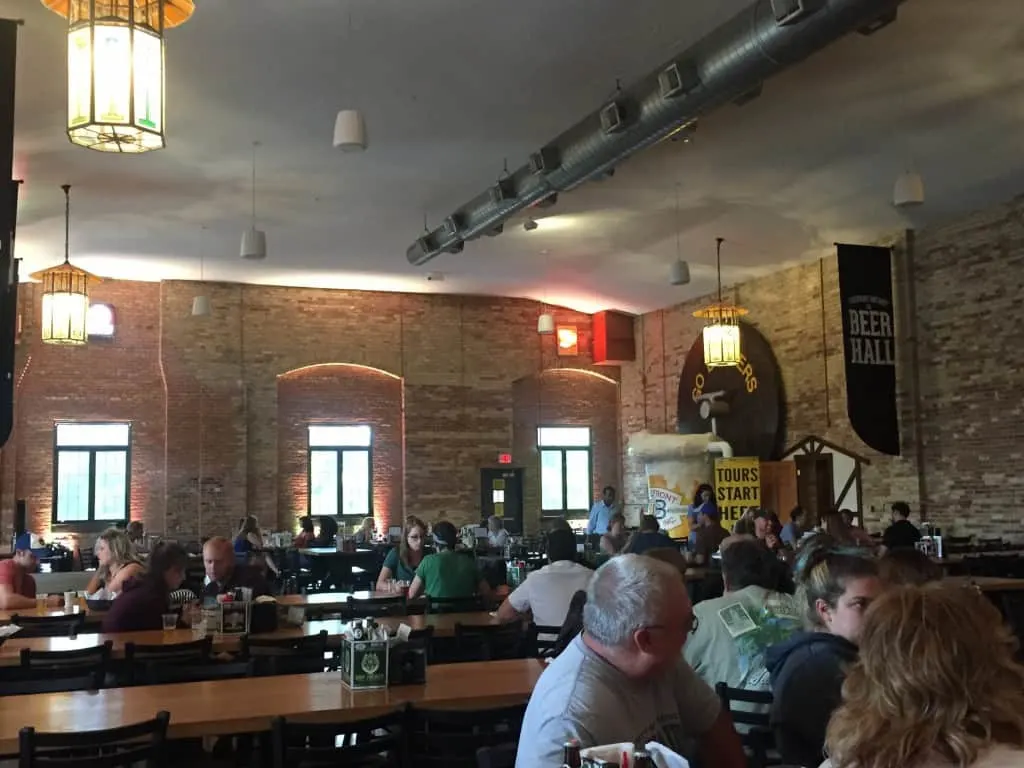
Lakefront Brewery Beer Hall
For a look at what modern Milwaukee beer brewing is all about, we visited its pioneer microbrewery, Lakefront Brewery. Home-brewing brothers Russ and Jim Klisch parlayed sibling rivalry into a startup business in 1987. By 1998, they’d outgrown their space and turned to the former Milwaukee Electric Railway and Light Company’s coal-fired power plant, built in 1908. Lakefront’s irreverent 45-minute tour includes four 6-oz beer pours at varying stations along the way and a souvenir pint glass. Our guide, Josh, was hilarious:
Lakefront’s atmospheric Beer Hall serves local food in homemade offerings ranging from Bavarian Pretzels with Polish mustard to local cheeses, famed Usinger beer brats and braunschweiger sammies.
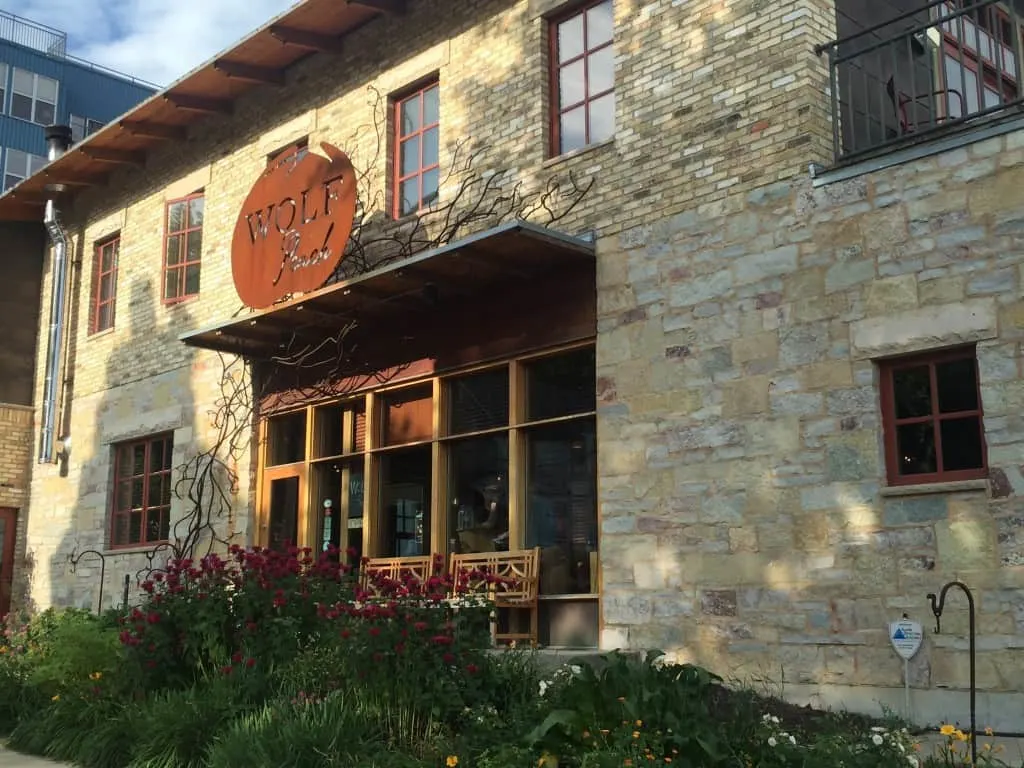
Wolf Peach Restaurant
Exit the Lakefront Brewery (which is really on the riverfront, but who’s quibbling?) and head up Brewer’s Hill to Wolf Peach at 1818 N. Hubbard, Tel.(414) 374-8480. Here you’ll be served rustic European comfort food made of seasonal, regional ingredients from the restaurant’s on-site garden and local farms. These come out in large and small plates, not in courses, as they’re completed in the kitchen. The result is an opportunity to pay attention to each other, accompanied by delicious food and drink.
- Wolf Peach serves you at communal tables in a rustic Old World atmosphere
“Wolf Peach,” so the menu informs, is the literal translation of the Latin name for tomato. Upon introduction in medieval Europe, the tomato’s acids reacted with pewter dishware, causing poisoning among the aristocracy. Peasants who used wooden plates were safe. One thing led to another, and soon the legend grew to suggest that the tomato could be used to summon werewolves. I summoned a Wolfhound myself, the barkeep’s take on my favorite cocktail. Have a look:
In modern Milwaukee, when the spirit moves you, or rather you’re moved to try spirits, you’ll want to consider Great Lakes Distillery. Founder Guy Rehorst has developed a small batch roster of gin, brandy, rum, vodka and whiskey products using local ingredients and old world methods.
Your $10 tour includes tasting: you’ll get a flight of six (with non-alcoholic options for teetotalers) different Great Lakes liquors along with it. An Argentinean Barbecue is held on the patio at happy hour, providing tasty tapas to complement your beverage. Find the distillery in the Walker’s Point neighborhood at 616 W. Virginia Street. Tel. (414)431-8683.
Old World Third Street Heritage Includes America’s Finest Sausage and Mader’s Medieval Antiques
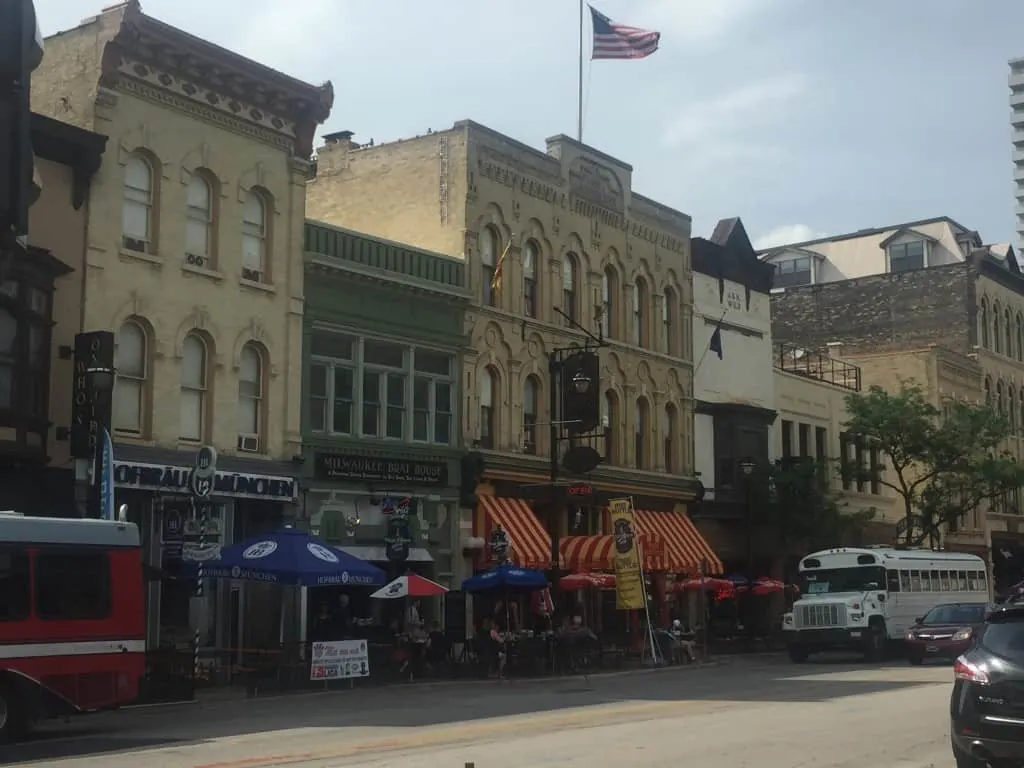
Historic Third Street, Milwaukee
Fred Usinger arrived in Milwaukee with a princely $400 and treasured recipes from his stint as an apprentice “wurstmacher” in Frankfurt. Purchasing a widow’s butcher shop in 1880, he married her niece and they moved above the store. For the next 60 years until his death, Fred served Usinger’s Sausage to Milwaukee’s German elite and developed a mail order business which shipped product across the country. Usinger’s storefront is still a marvel today with original ovens, vintage photos, and historical relics. Whimsical painted friezes of elves and decorative tile are original to the store. Recipes used for over 70 varieties of old world sausage date back to the 1880s. You can find Usinger’s sausage at their retail outlet, order it online from their website, and served in Milwaukee’s finest restaurants.
Across from Usinger’s at 1041 North Old World Third Street on the corner of Highland Avenue, Mader’s Restaurant lets you know that it has been preparing for your visit since 1902. We popped into the Knight’s Bar to check out part of Mader’s $3 million dollar collection of medieval antiques and art. I couldn’t resist their apple strudel while perusing the Specialties Menu. We would have loved to try the German Sampler, which features sauerbraten, wiener schnitzel, goulash, and spaetzle. Other schnitzels, rippchen (a smoked pork loin served with kraut), and different wursts and potato dumplings bring Old World goodness to your palate. Mader’s is the most famous German restaurant in America with good reason!
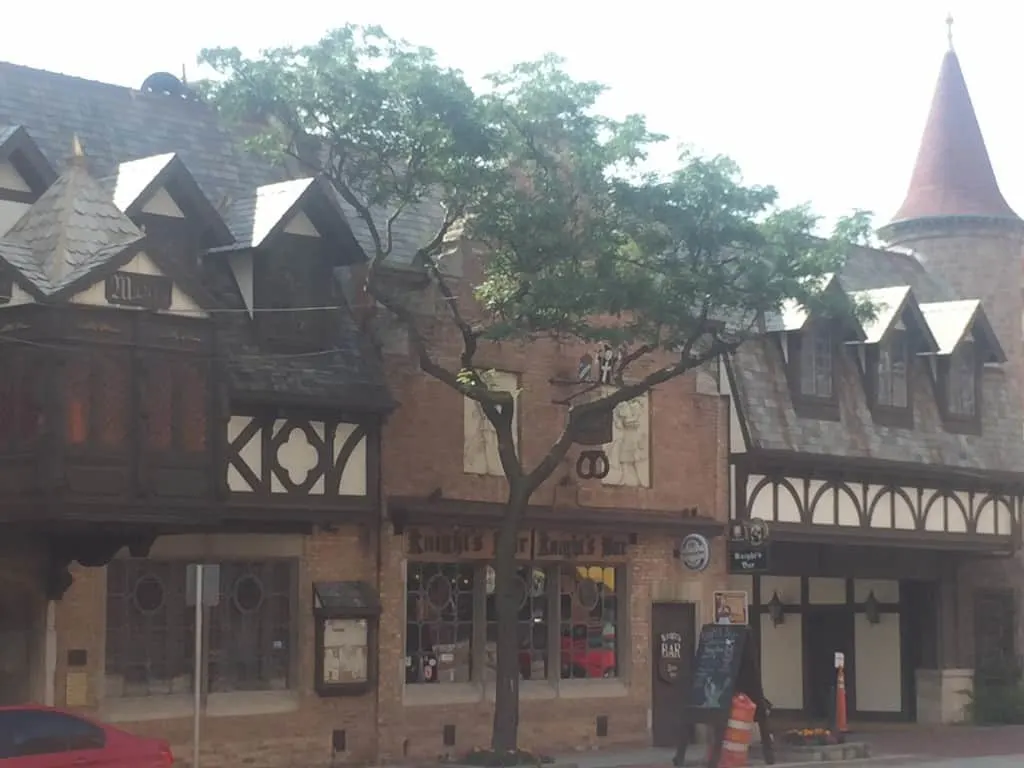
Mader’s Restaurant
Thrift and Community Made Milwaukee the “Gem of Polish Settlements in America”
“. . . try always to remember my last Wishes that you my dear Children shall live in harmony & mutual confidence, each doing all in his or her power to keep the estate productive of the best results, for the interest not of any one Child, but for all surviving Children.” – Pabst letter.
Poles emigrated to Wisconsin for economic reasons: low wages and the next to impossibility of obtaining land. Initial growth was relatively slow: between 1855 and 1865 when the first Polish church was established, Milwaukee’s Polish population grew from one to thirty families. However, things changed in 1871, when German Chancellor Otto von Bismarck decreed all inhabitants of Prussia should speak the German language. In a further attempt to unify the German state, control of parochial schools was transferred to the Prussian government. Another law banished Jesuit priests from the German empire, and still another required 4 years of Army service for every young Pole. This change of circumstances induced many Poles to leave for the New World.

Tannery Row Buildings of Cream City brick where Polish immigrants worked adjacent to the riverfront are now condo conversions
By 1872, the original Polish church was too small to accommodate the influx of newcomers.
St. Stanislaus Parish, on the corner of Grove and Mitchell just beyond Walker’s Point, laid the cornerstone for a new church built with the help of residential mortgages taken out by parishioners. At least one, a certain Jan Polaski, who had arrived in Milwaukee in 1852, sold a cow in order to donate to the building fund. Each family’s $30 gift – the equivalent of a month’s salary – was duly recorded.
St. Stanislaus is a beautiful Polish Cathedral style edifice rendered in Cream City brick, which quickly became the centerpiece of Polish life. It remained so for most of the 20th century. After a period of decline beginning in the 1970s, the Diocese reintroduced the 1962 Latin Rite Mass in 2007. Subsequently, the church’s congregation has swelled with new families eager to celebrate the traditional liturgy. This year, St. Stanislaus celebrates its 150th birthday with a comprehensive plan for care and restoration.
History and Restoration of St. Stanislaus Church video:
Brady Street – An Architectural and Ethnic Sampler in Modern Milwaukee
In another Polish neighborhood on Milwaukee’s East Side, St. Hedwig’s, whose current congregation has now been consolidated into the Three Holy Women Parish, was a simple wooden building on Franklin Place dating from 1871. In 1887, it was replaced by a Gothic Romanesque building constructed of Cream City brick, located at 1702 N. Humboldt off Brady Street. Mass was said only in Polish at St. Hedwig’s until the 1920s.
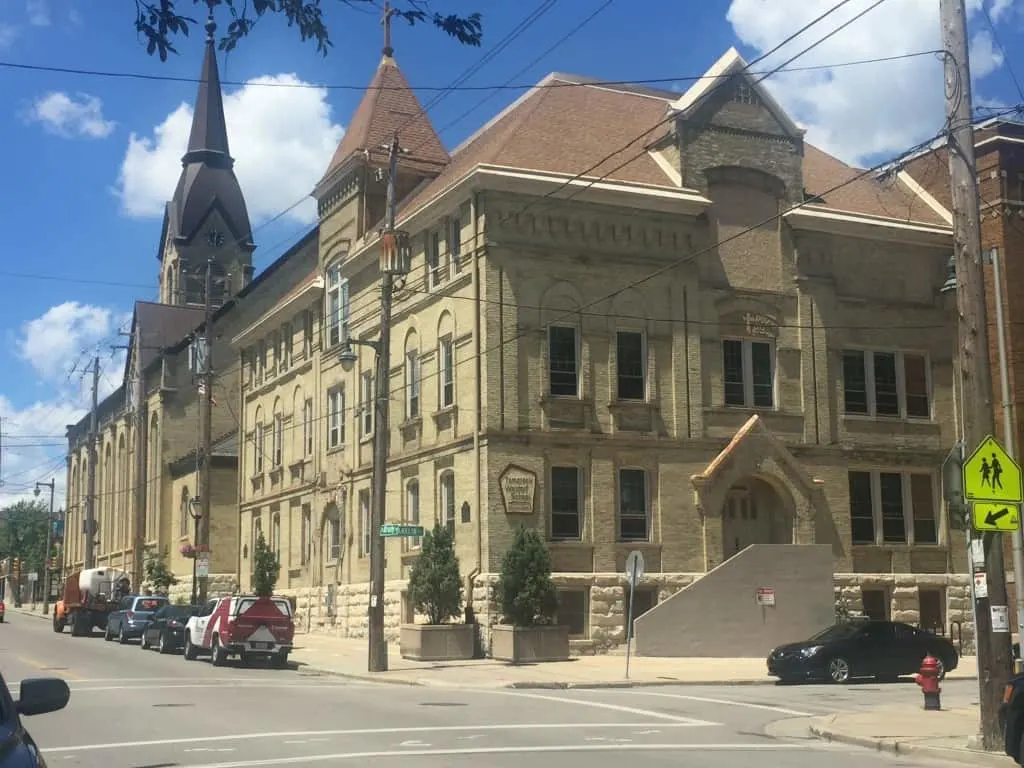
St. Hedwig’s School and Church
“The large majority of the Poles are common laborers. They are employed in the factories and upon the streets. In every large Polish settlement there are Polish shopkeepers of all kinds. The majority of them are in the cities, but these are forming communities in the vicinity of all the larger settlements. Their industry and thrift are evidenced by the fact that a large number of Polish workmen in Milwaukee own their homes, although their wages are less than $1.50 a day.” – The Polanders in Wisconsin, by Frank Hayden Miller, published in 1896. Public domain. Electronic edition published by the Wisconsin Historical Society.
Historic Brady Street, we learned on our tour with Milwaukee Food and City Tours, is now a fashionable enclave, but this wasn’t always so. Growing their community back in increments from the riverfront where their tannery and brick-making employers were located, Polish immigrants bought narrow lots and built single story wooden cottages on them. When finances permitted, working families jacked up their cottages and made living space in the low new basement underneath. These “Polish flats” still remain in much of the Brady Street neighborhood.
- Polish Flats were raised on new foundations for additional living or rental space as owners could afford.
- Polish Flat built for narrow lot
- Row of Polish flats. Lower levels cannot now be legally occupied due to modern building and safety codes.
In the mid-1880’s, a tour by tax advocate Henry George and a gentleman by the name of Bill Hooker, revealed,
“There were many blocks completely covered with small, neat cottages, set rather close together, but each having a back yard, for most of the lots were 30 by 120 feet, running back to an alley. ‘I suppose,’ said Mr. George, ‘that these houses have been put up by a company, as they seem to be quite alike, and then sold on time payments or rented to the occupants.’ He was told that this was not a mass production affair at all and that comparatively few of the residents were renters; so to confirm this statement I suggested that go to every door on one side of a block and make inquiry. Every householder said he owned the house, and everyone was a Pole, and expressed pride in his or her ownership. Mr. George was amazed, saying, after crisscrossing the neighborhood for an hour or two, that he had a new economic idea, and was astonished at the evidence of assimiliation [sic] among the Poles, their industry and their great value as citizens.”
Today, the cream brick tanneries and brick manufacturers where immigrant laborers toiled have been converted to condos, restaurants, and other new purposes along the riverfront in what has become prime real estate. Check out the Red Lion Pub on Tannery Row , which occupies a couple of floors in a cream brick building at 1850 Water Street, tel. (414) 431-9009.
We stopped at Wolski’s Tavern to cool off with a refreshing brew, which can be had for as little as $2.50 on Tuesdays. Family-owned Wolski’s is located at 1836 N. Pulaski, tel. (414) 276-8130, a diagonal street of Polish flats which originally followed the path of an underground stream from Brady Street to the river. Well over 100 years old, Wolski’s is deemed legendary as dive bars go by diverse authorities such as Mashable and Esquire Magazine. Come for free popcorn, cheap beer, pool and darts. If you close the place, you’ll get a bumper sticker with which Wolski’s patrons photograph themselves all over the world.
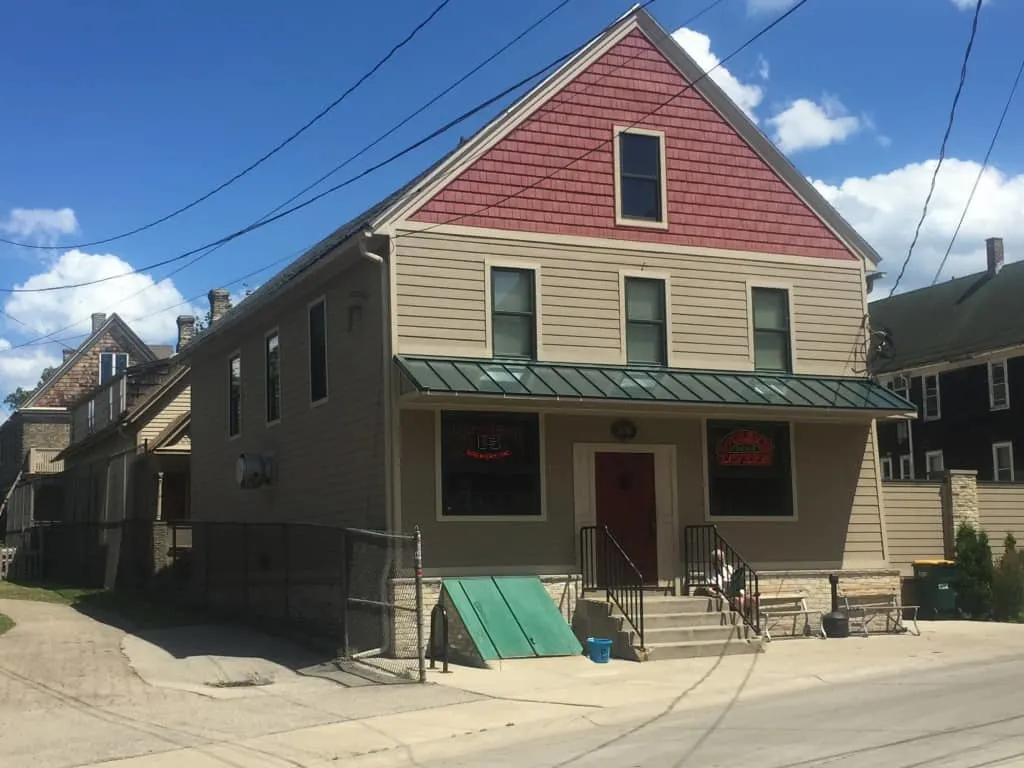
Wolski’s Tavern, since 1903
After the Poles came the Italians, and with them the flavors of the Brady Street neighborhood changed. We visited at Peter Sciortino’s Bakery for traditional cannolis on the corner of Humboldt and Brady. These and other confections have earned Sciortino’s the title of Best Bakery in Milwaukee. Who are we to dispute?
- Sciortino’s Bakery
- With 92-year-old Uncle Joe Glorioso
- Glorioso’s Italian Deli and Grocer
- Brisk business at Glorioso’s
We then wandered up to Glorioso’s Grocery, where 92-year-old Joe, one of the brothers who founded it in 1946 after coming home from overseas in WWII, was at work, as he is most days. He likes nothing better than taking a photo with a “younger woman.” I was happy to oblige him and claim the moniker! Joe told us neither he nor his brothers really wanted to open a grocery, so of course that’s what they did. Now Glorioso’s stocks over 30,000 products in the former neighborhood theater building down the block from St. Hedwig’s.
Other notable stops on our tour: Zaffiro’s Pizza at 1724 N. Farwell Avenue, tel. (414) 289-8776, a red-checkered tablecloth casual restaurant which has served thin-crust pizza and other homemade specialties since 1954. Cempazuchi, at 1205 E. Brady Street, tel. (414) 291-5233, serves tequilas, margaritas, and “comida brava” in a colorful atmosphere which celebrates the Mexican tradition of sharing.
Bay View – Newly Hip Neighborhood Steeped in Tradition
“Be generous and unselfish to each other in Case of need and above all, be honest and noble, in all your dealings, not only with each other, but with the World.” – Pabst letter.
Bay View was first permanently settled in 1834 by Horace Chase, a future mayor of Milwaukee. Thirty-four years later, the Milwaukee Iron Company transitioned Bay View into a company town. In the 1870s new immigrants who had come to work in Bay View blast furnaces were welcomed by Beulah Brinton, who opened her home to serve as a library and social center for women and their families. This was a forerunner to similar efforts by Jane Addams at Hull House in Chicago and University Settlement in New York City. Today, the Bay View Historical Society has offices in the house.
“Sickness, Misfortune, perhaps something worse can come to someone of you, but my dear Children, face it bravely. . .” – Pabst letter.
In 1886, Polish laborers who had organized at St. Stanislaus joined 7,000 building trades workers in demanding an eight-hour work day. A combined group of about 14,000 workers clashed with National Guardsmen at the Milwaukee Iron Company in what became known as the Bay View Massacre, resulting in seven deaths. The next year, Bay View was annexed into Milwaukee and provided with public improvements.

Rolling Mills at Bay View Milwaukee in 1882. Image: Public Domain via Wikipedia
By 1933, Milwaukee’s Polish community of about 125,000 residents was regarded as the “gem of Polish settlements in America,” according to a Milwaukee Journal article from June 18 of that year, titled “Braved hardships to build homes.” Today, Bay View is melding a primarily working-class neighborhood with a young, creative vibe. Called the “bubble we’d all be so lucky to be stuck in” by Thrillist, Bay View is hip.
You can start your day in Bay View, as we did, at Colectivo Coffee Bay View, on a prime corner location at 2301 S. Kinnickinnic Avenue (Tel. 414-744-6117). The two-storycafe offers a variety of seating options, including a patio and a counter where you can watch professional young bakers who really like their job at work in the attached Troubadour Bakery.
Troubadour bread is proudly “slow-made” with old world techniques, natural leavening, and long fermentation. The bread is then baked in the Troubadour’s custom stone hearth oven which was shipped from Italy. Colectivo coffee is hand-roasted and sourced from long-term farmer and cooperative partnerships. Open daily from 6AM – 9PM, 10PM on Fridays and Saturdays.
Down the street at Cafe Centraal, 2306 S. Kinnickinnic Ave., tel. (414) 755-0378, we experienced a bit of deja vu. Having tried our fair share of Belgian beers as part of cafe culture in Brussels, we were anticipating a good time sampling from Cafe Centraal’s “Bierbook” and we weren’t disappointed. Fifteen pages of selections run the gamut: ales, ambers & reds, pilsners, IPAs and microbreweries, sours, and even fruit and gluten-free beers.
If you’re not into beer, you can complement your delicious Low Country influenced meal with a full range of wines and cocktails, poured behind one of the longest bars we’ve ever seen. Cafe Centraal’s parent company, the Lowlands Group, offers four “grand cafes” throughout Milwaukee, a brew collaborative, and community-building initiatives such as their educational “Bierklasse,” and clubs for cycling and bier enthusiasts.
Not quite ready to call it a day? Milwaukee’s Craft Beer Garden is located in Bay View’s Humboldt Park, the city’s oldest dating from 1891, at the corner of Howell and Oklahoma Avenues. Here, Milwaukee County Parks and St. Francis Brewery team up to promote craft beers in a traditional beer garden atmosphere: glassware deposit, smoke-free, cash only (with onsite ATM). Fun activities include live polka, Saturday pig roast, and Trivia Wednesday. Small bites, soups, salads, sandwiches, wursts and pizza. A changeable beer list includes seven local brews with roots in Belgium, Bavaria, Czech Republic and India. 3000 South Howell Avenue. Summer music season on Tuesday nights. Closes for the season at the beginning of October.
The Vanguard Bar at 2659 S. Kinickinnic Avenue (Tel. 414-539-3593) has foodies flocking for classic and styled sausage, or tubeless options like the “Dirty Burger,” cheese curds and poutine. Included in Food Network’s list of 40 Best Bars in America for Food Lovers, the Vanguard is a mix of fine food and cocktails in a neighborhood corner bar atmosphere. Community bistro seating, and the kitchen is open until 1AM Thursdays-Saturdays.
Historic Third Ward – Home to Italians and Irish – Undergoes a Renaissance in Modern Milwaukee
“I can not say more in this Letter, it is merely a last Word to you all, begging you to remember your Father’s last wish, that you each, and all, do all you can, to promote each other’s happiness & welfare through life, no Matter what changes may come, or how one may be favored, or another be frowned upon by the fortunes of the World.” – Pabst letter.
In the 1850s, arriving Irish famine refugees turned laborers built simple wooden houses in former wetlands between Lake Michigan and the confluence of the Menomonee, Kinnickinnic and Milwaukee Rivers. The resulting Third Ward was a rough neighborhood, with a large number of saloons and brawling scrappers who were arrested more than five times as frequently as their fellow citizens in other enclaves. The concentrated population provided political support to its own, electing Irish mayors and aldermen to lengthy tenure. An 1892 fire, near what is the Public Market today, caused residents to relocate. Buildings that went up in place of the destroyed housing were commercial in nature, housing warehouses and manufacturers.
As the Irish left, Sicilian Italians replaced them, forming a community around the Blessed Virgin of Pompeii Church, celebrating festival days with parades and recreation. The neighborhood remained poor, even through 1950s urban renewal efforts. Many dilapidated buildings – including the church – were simply condemned and torn down, reducing the population by thousands down to just over 200 in 1960.
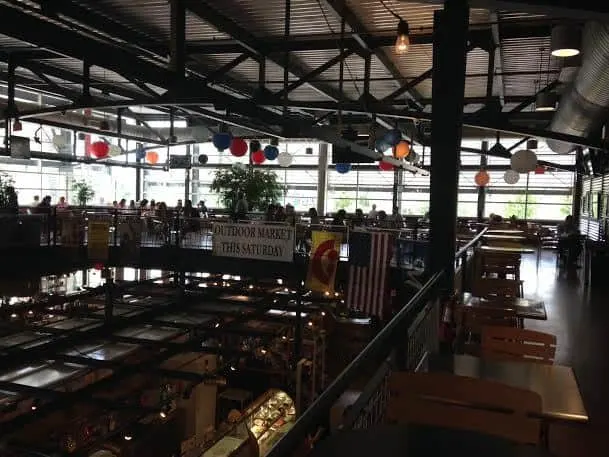
Milwaukee Public Market
In the 1970s, repurposing breathed fresh transformation into the Historic Third Ward: vintage buildings became salons, fashionable stores, restaurants, and housed the Milwaukee Institute of Art ad Design. Now, the neighborhood has a variety of eating and drinking establishments which specialize in world cuisine. New riverfront housing developments have reinvigorated the area, which has several thousand residents at present.
Milwaukee Public Market bills itself as the centerpiece of Milwaukee’s Historic Third Ward. A gathering place to promote “a different way in which consumers shop, cook, eat and experience food,” the Market is home to vendors who purvey ethnic and specialty foods, wines and gifts. Classes and team building events are overseen by a number of chefs skilled in business and the culinary arts. The outdoor Urban Market is open every Saturday from June to October along St. Paul Avenue, featuring growers and artisans. We enjoyed a Mexican counter lunch at Margarita Paradise.
Cafe Benelux across from the Public Market at 346 N. Broadway (tel. (414) 755-0378) is another one of the Lowlands Group’s Grand Cafes. It was packed on Saturday morning as we prepared for our drive to Minneapolis. Named for the tri-country region of Belgium, Netherlands, and Luxembourg, Benelux’s “blunch” menu featured burgers and stacked sammies, with five kinds of Bloody Marys using vodkas infused with peppercorns, horseradish, cucumber and garlic.
Grabbing seats at the bar where we were entertained by the manic, yet competent pace behind the counter, I chose the Elderflower Nectar mimosa while Pete had a Duvel, his favorite from Belgium.
My Cinnamon Streusel French Toast was enormous, as was Pete’s Hodge Podge of cheddar, thick bacon, sausage, and fried eggs slathered with chorizo cream gravy and pico de gallo.
- Nope, these weren’t ours!
- Streusel French Toast
- “Hodge Podge”
Driving back to Minneapolis, I played loud music on the car radio all the way back while someone snored shotgun beside me. We’d had a great time, and went home with a slew of recommendations for great places to eat, drink, and generally just live well in modern Milwaukee.
Pinnable Image:
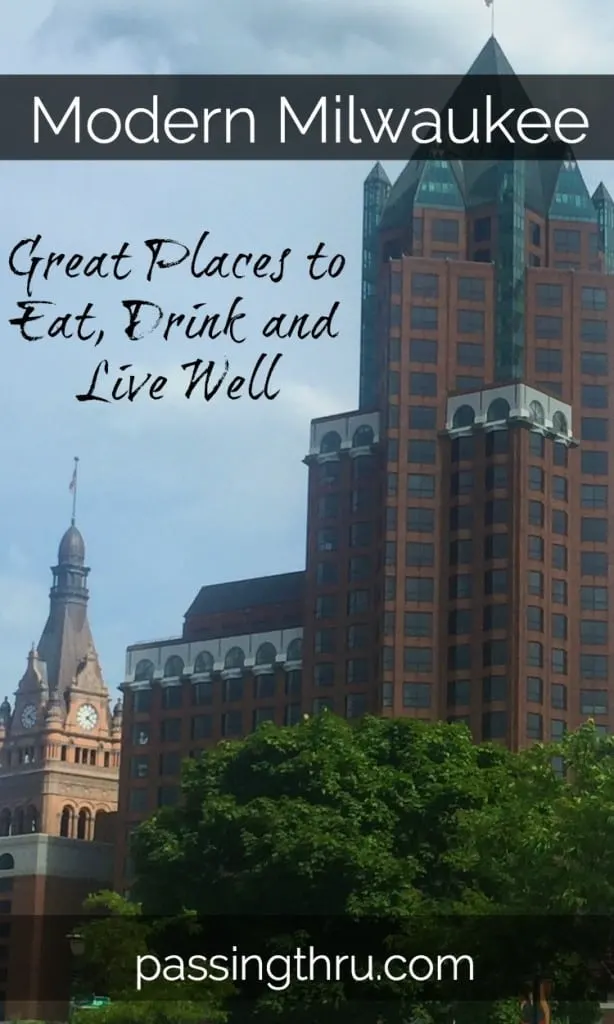
Tips and Practicalities:
We arrived in Milwaukee via High Speed Lake Express Ferry, which crosses Lake Michigan from Muskegon in the space of 2-½ hours. See our full on review of the Lake Express here .
While in Milwaukee, we stayed at Sheridan’s Boutique Hotel and the Potawatomi Hotel. Click the individual hotel links for our detailed review.
Disclosure: Our five-day experience in Milwaukee was organized and subsidized by Visit Milwaukee and its business partners mentioned herein.
Tips for Trip Success
Book Your Flight
Find an inexpensive flight by using Kayak, a favorite of ours because it regularly returns less expensive flight options from a variety of airlines.
Book Your Hotel or Special Accommodation
We are big fans of Booking.com. We like their review system and photos. If we want to see more reviews and additional booking options, we go to Expedia.
You Need Travel Insurance!
Good travel insurance means having total peace of mind. Travel insurance protects you when your medical insurance often will not and better than what you get from your credit card. It will provide comprehensive coverage should you need medical treatment or return to the United States, compensation for trip interruption, baggage loss, and other situations.Find the Perfect Insurance Plan for Your Trip
PassingThru is a participant in the Amazon Services LLC Associates Program. As an Amazon Associate I earn from qualifying purchases.
To view PassingThru’s privacy policy, click here.


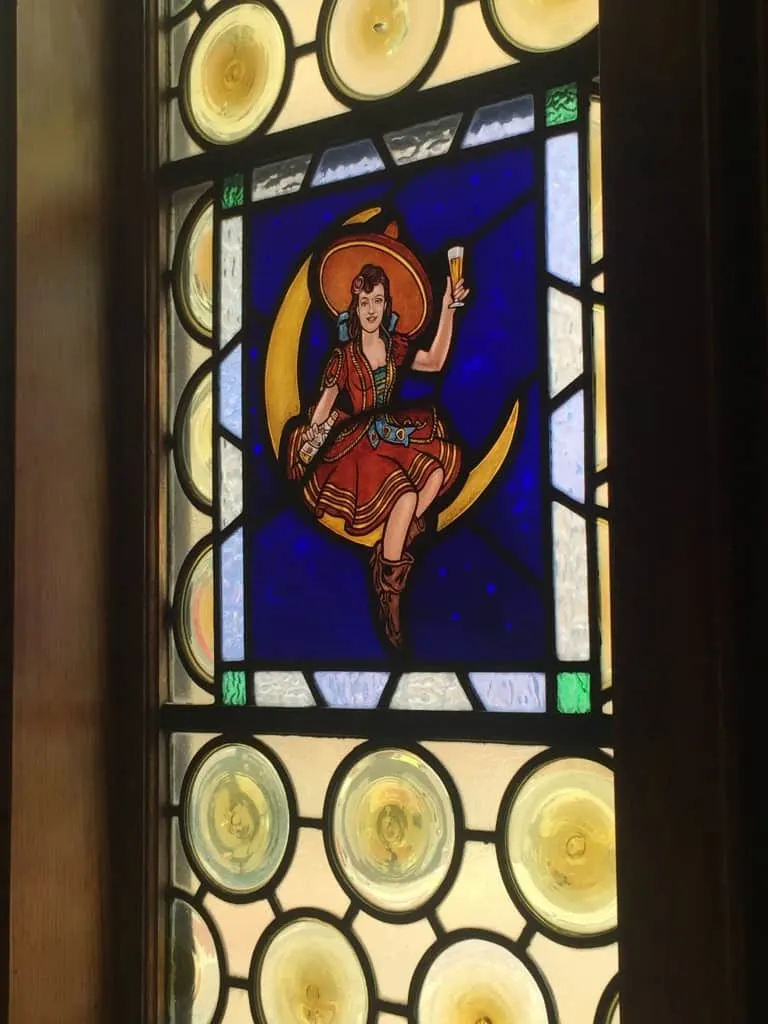
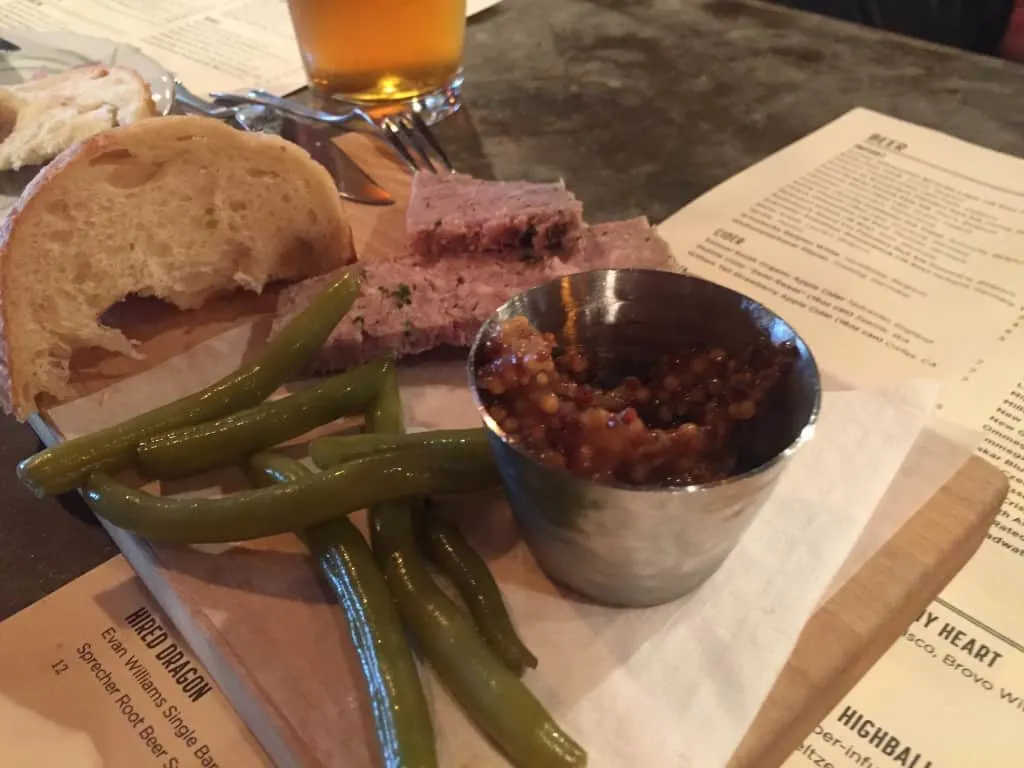
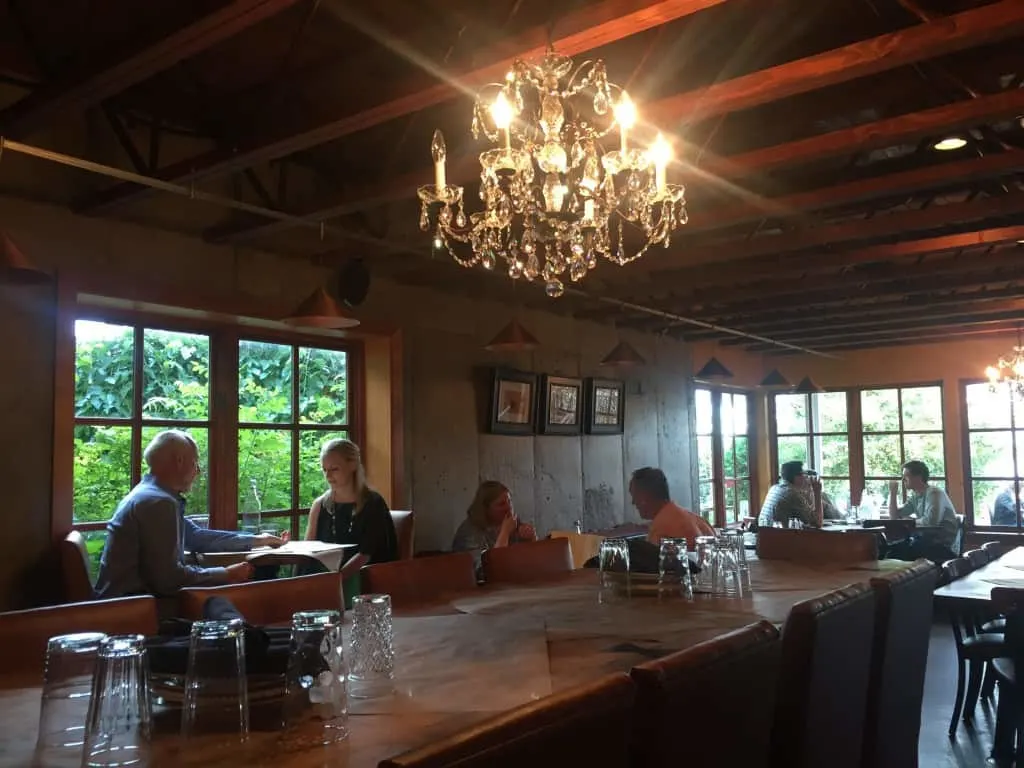
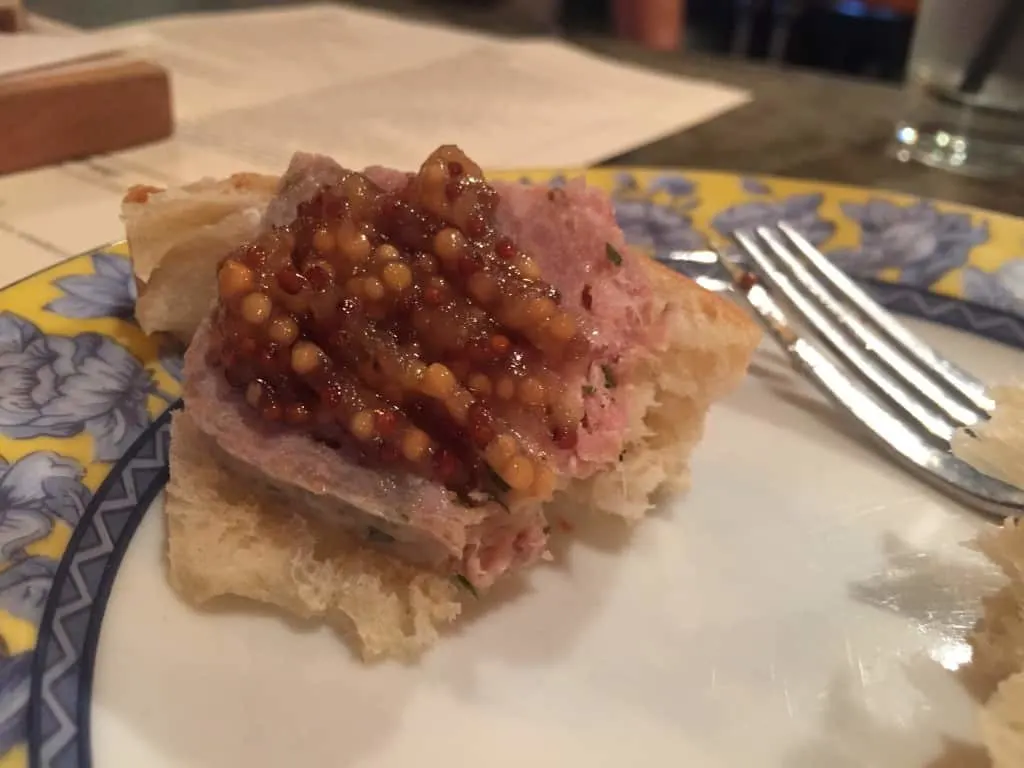
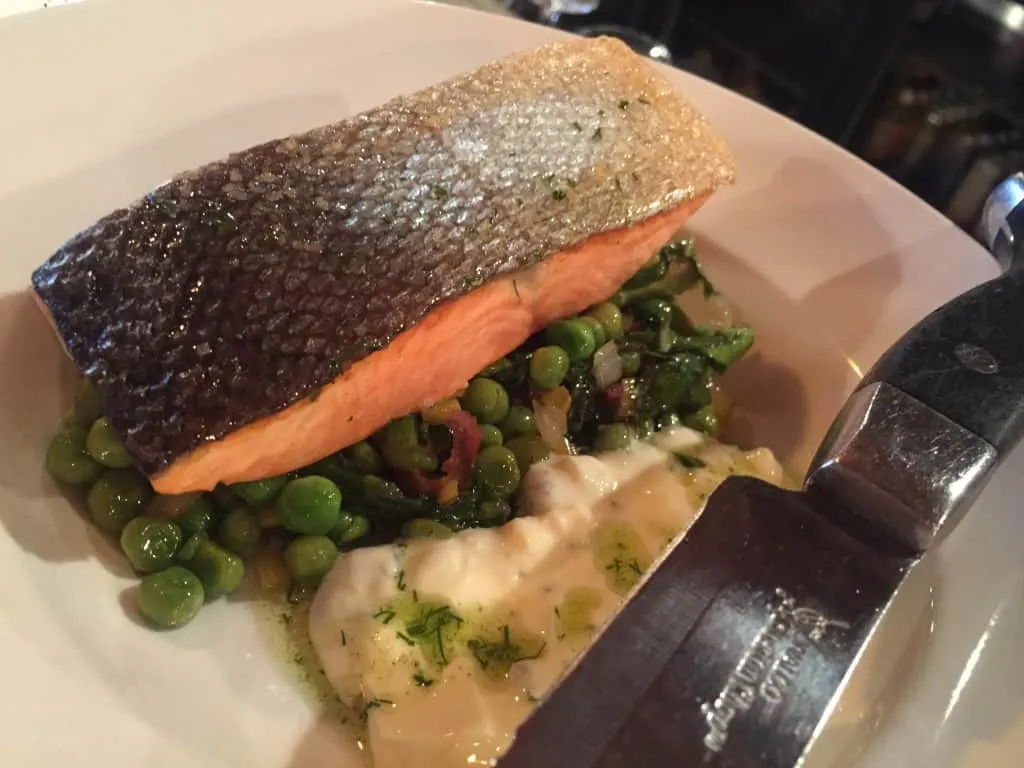
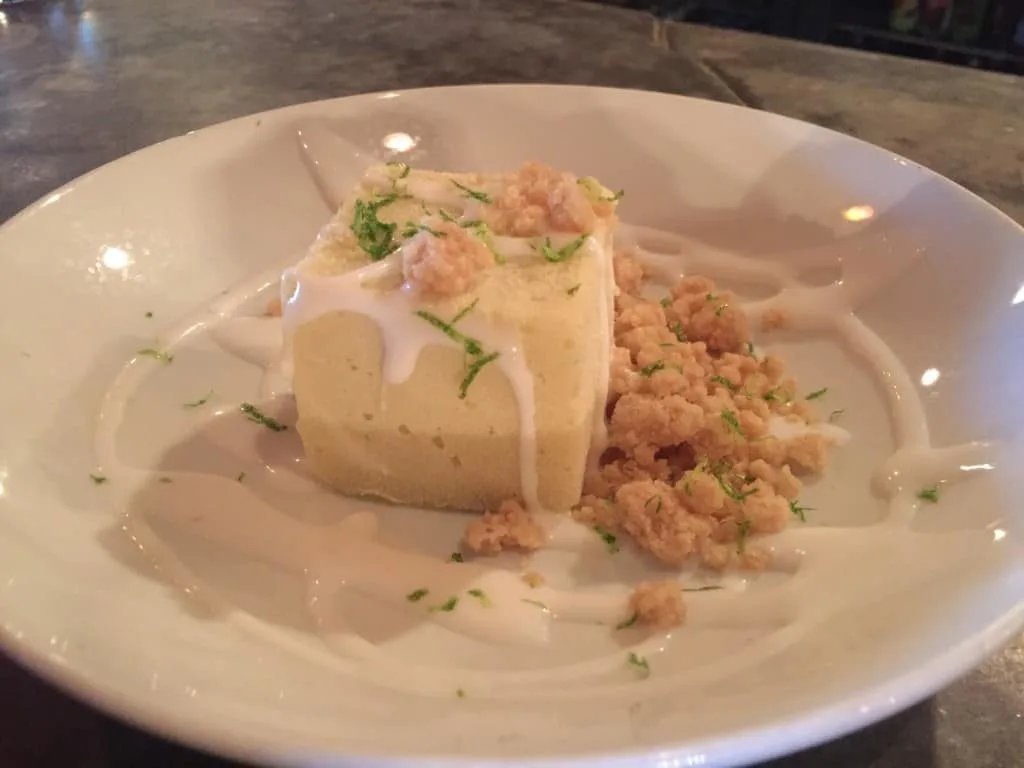
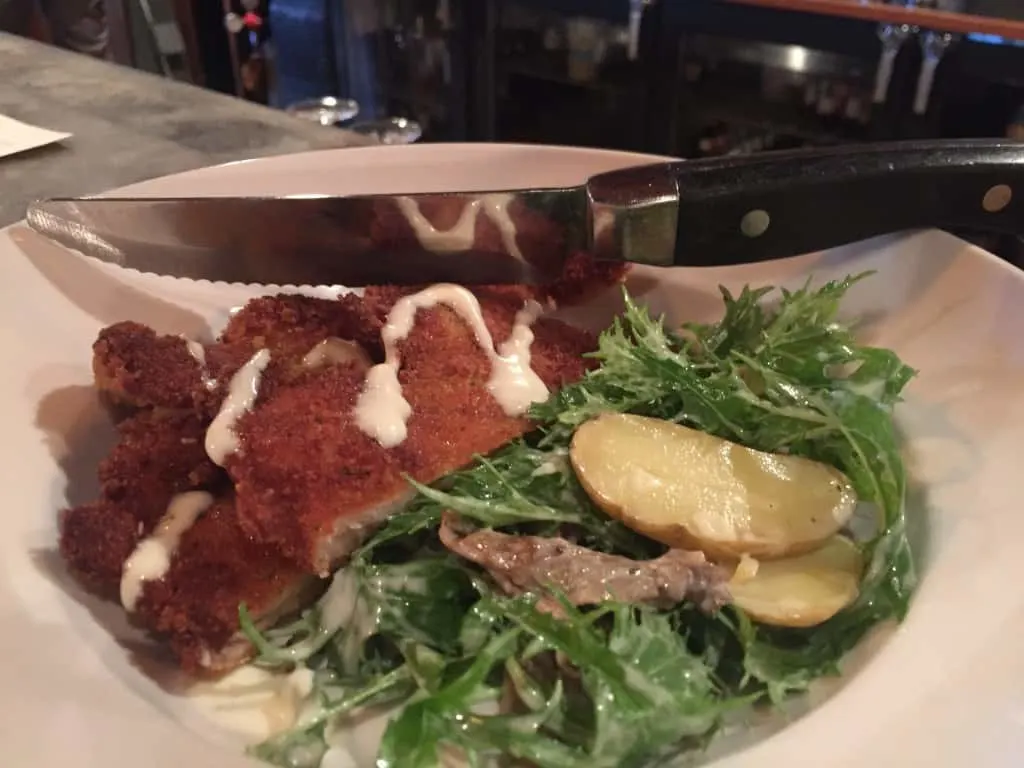
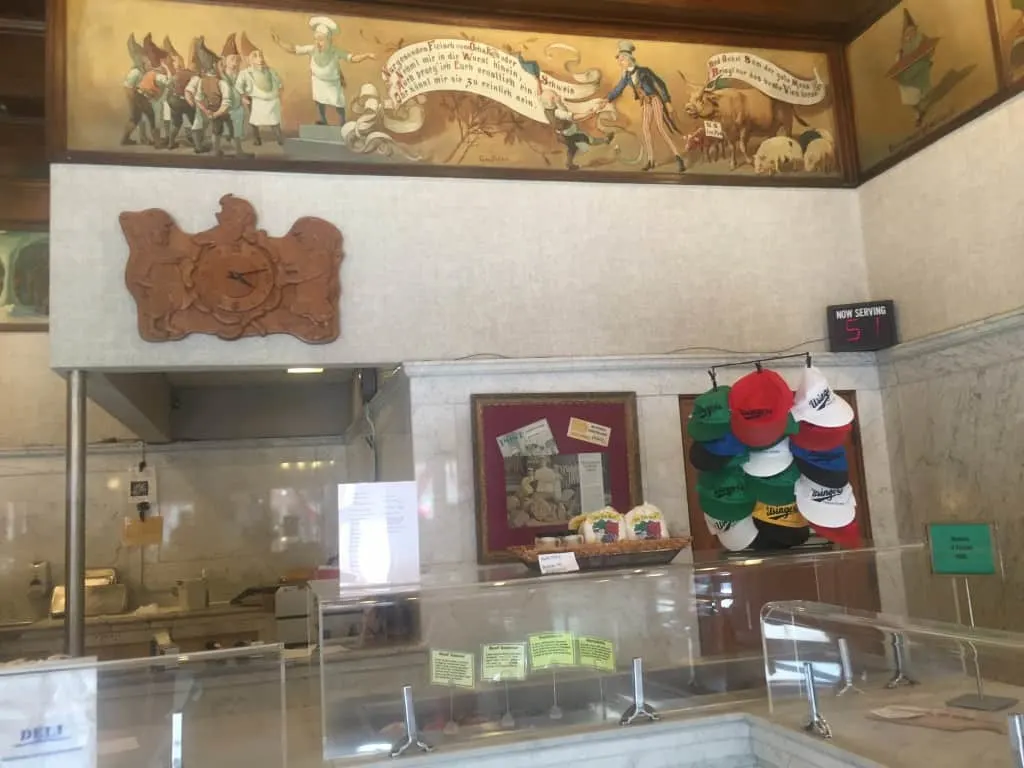

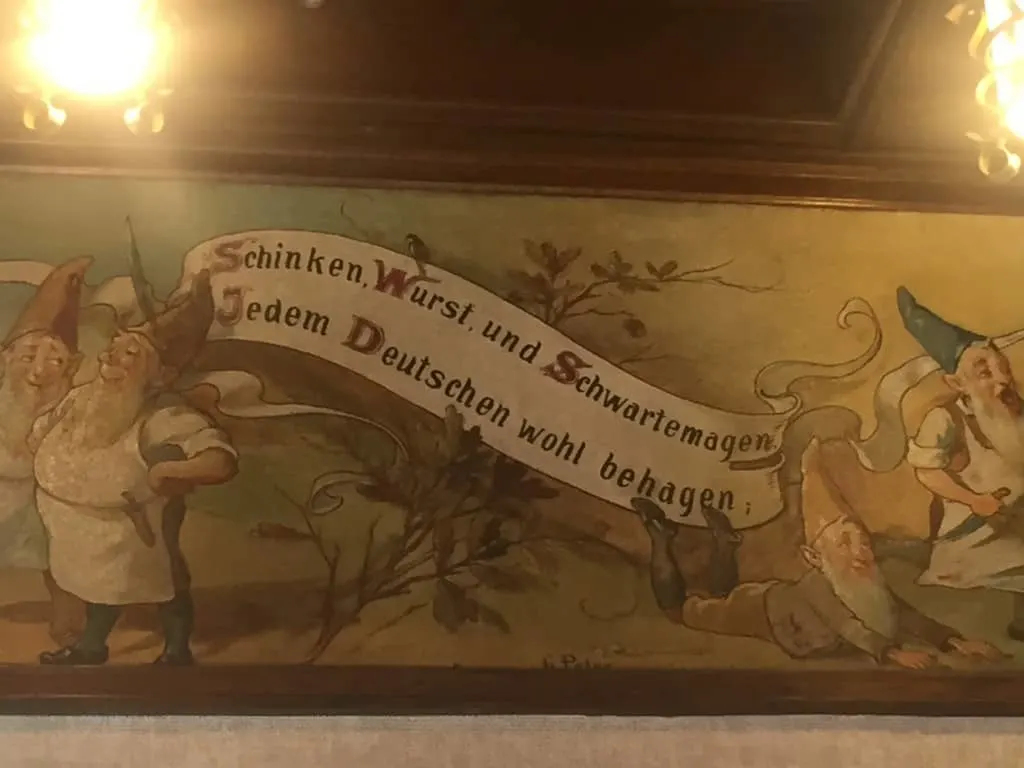
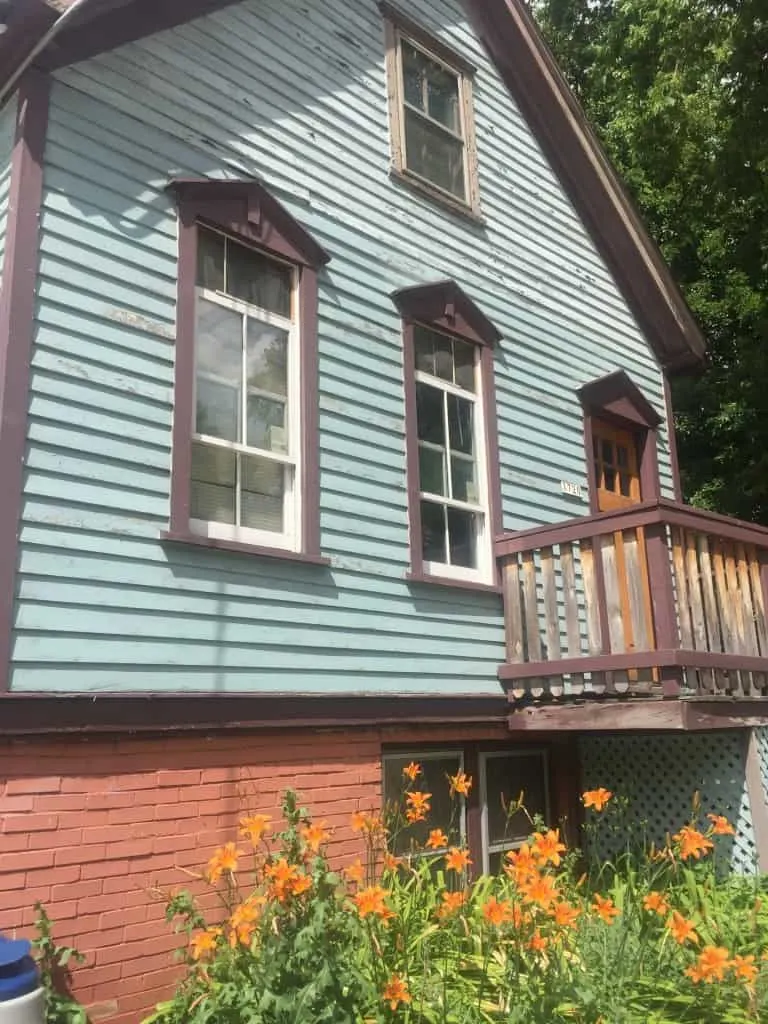
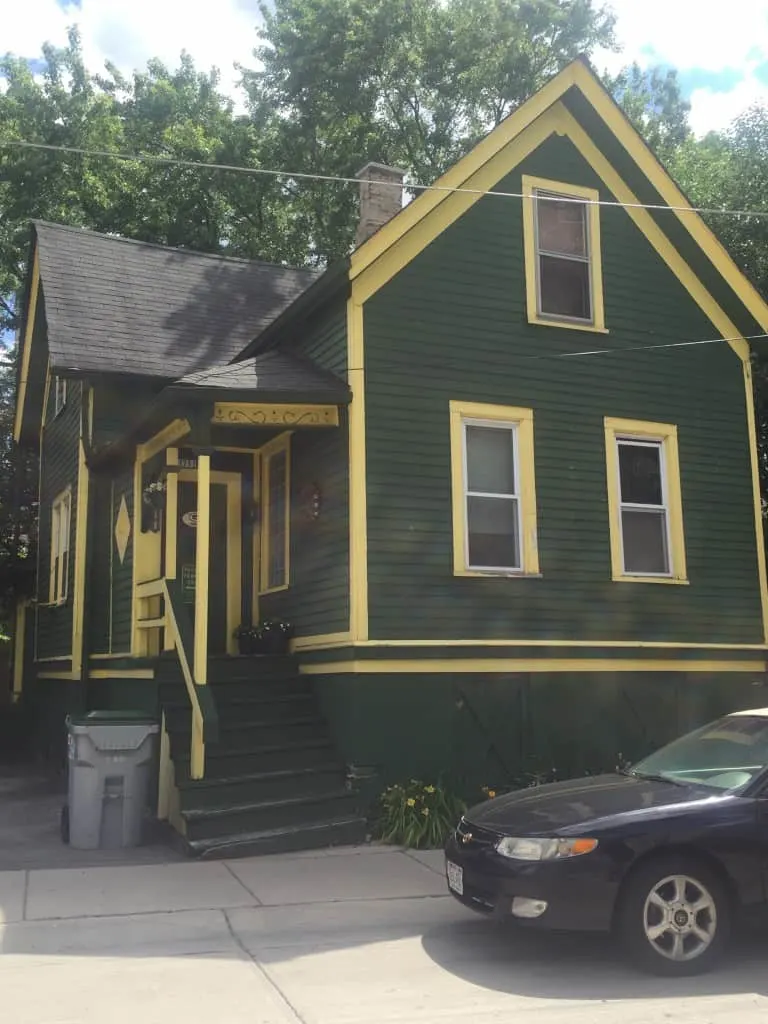
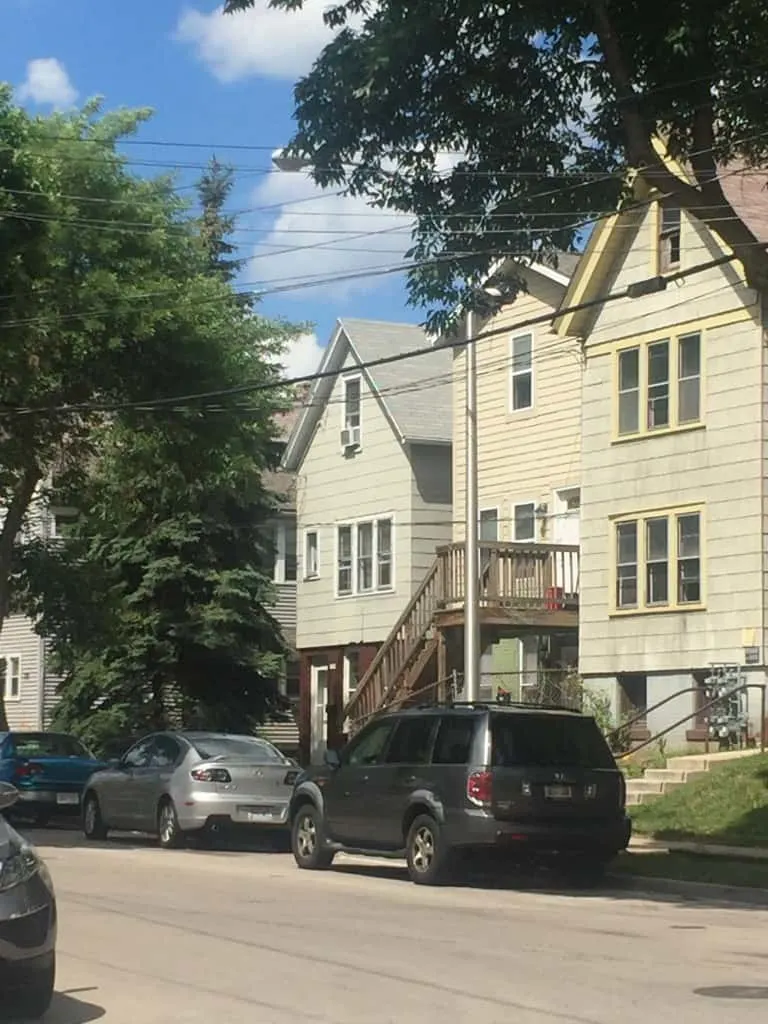
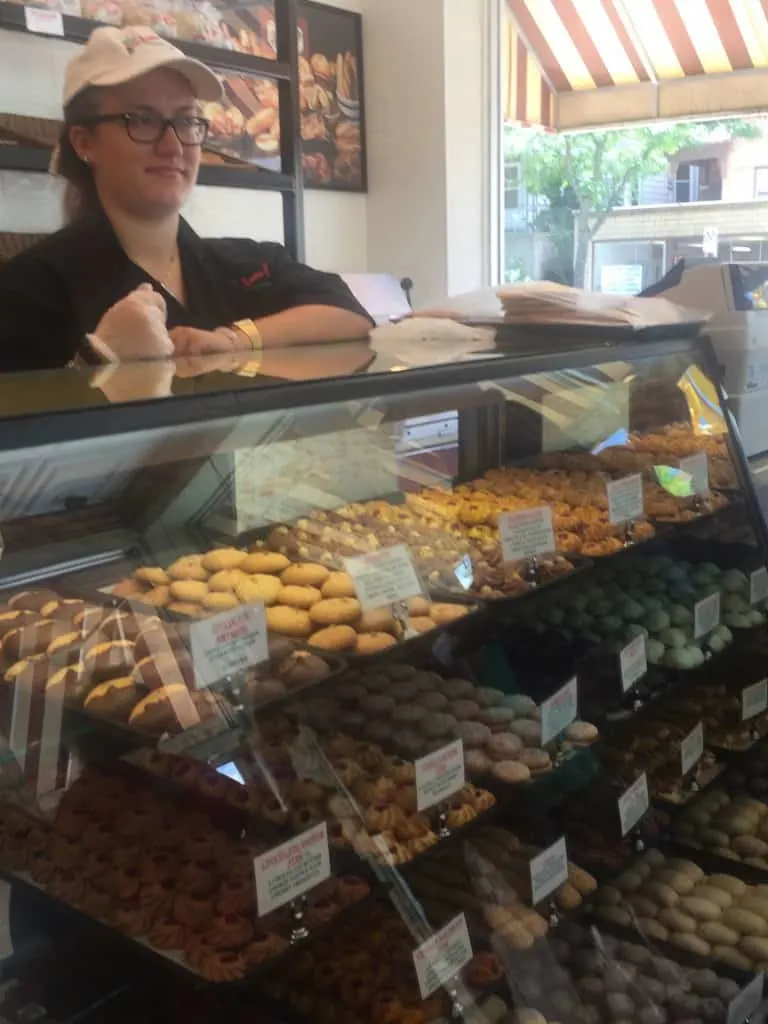
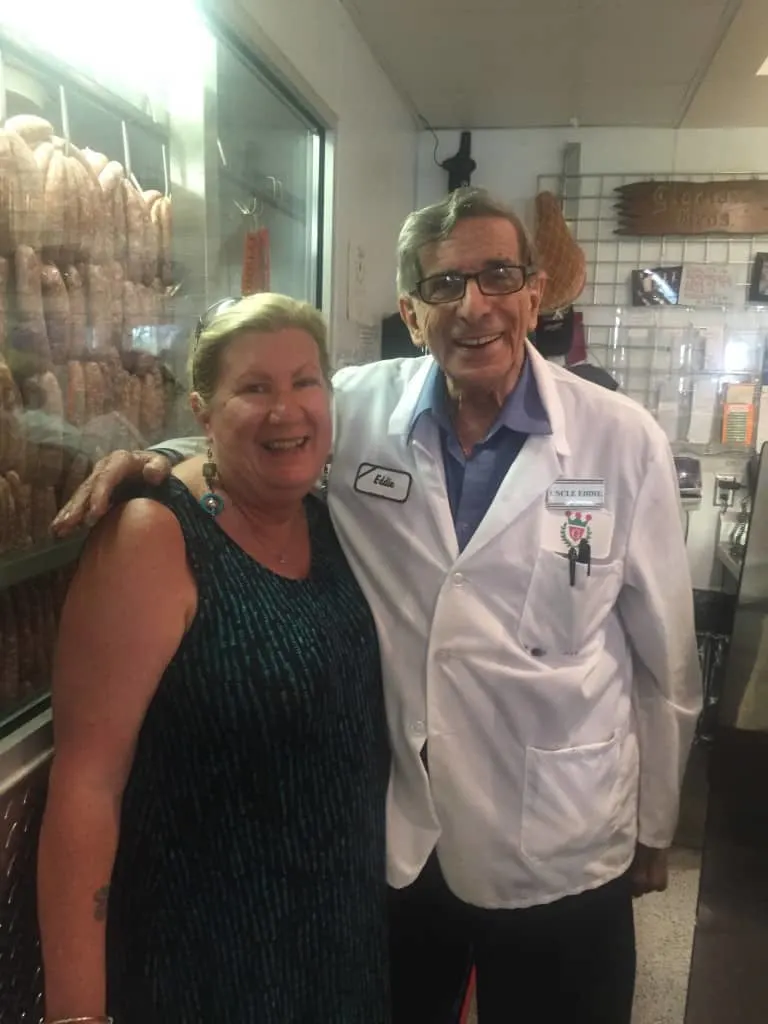

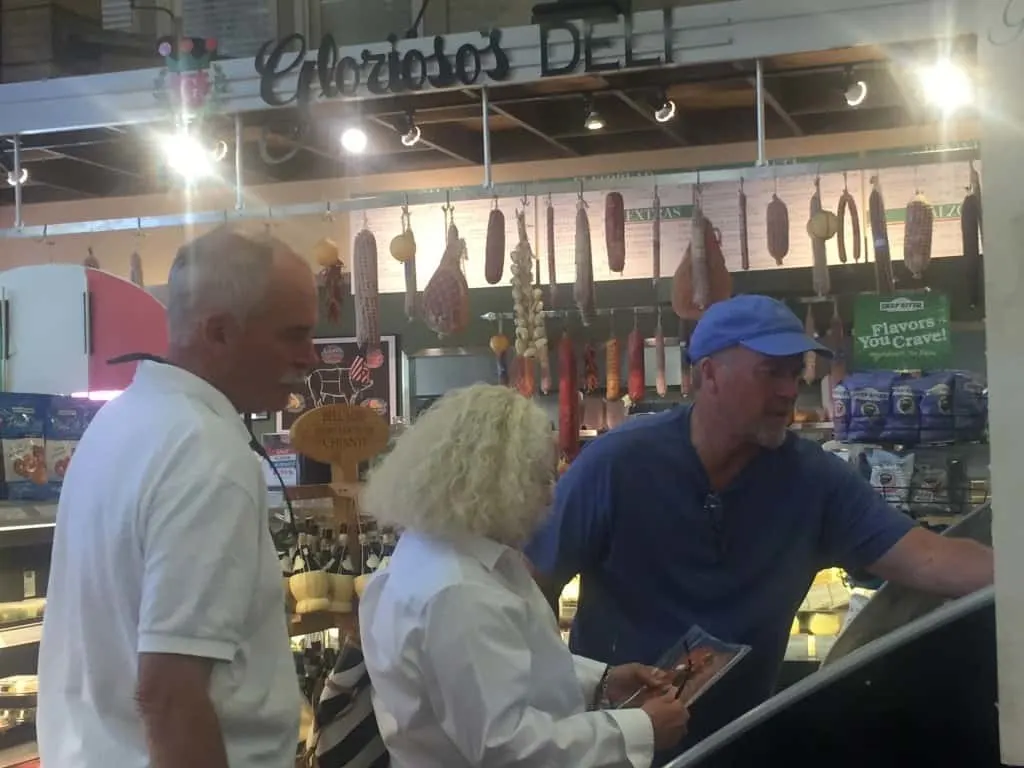
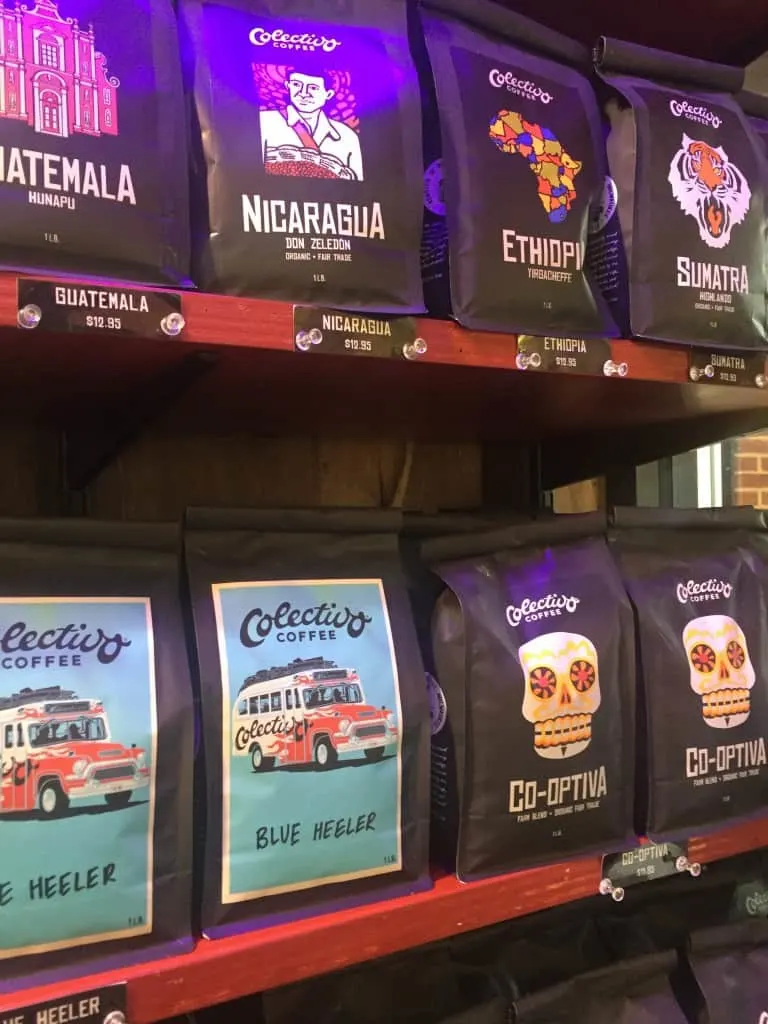
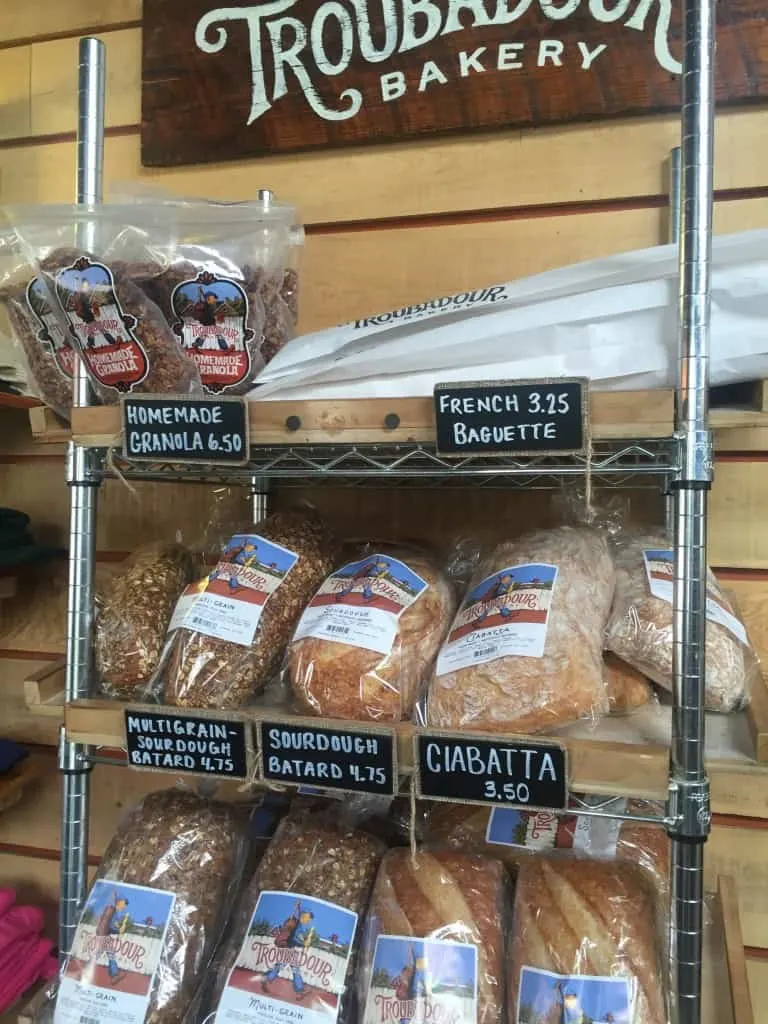
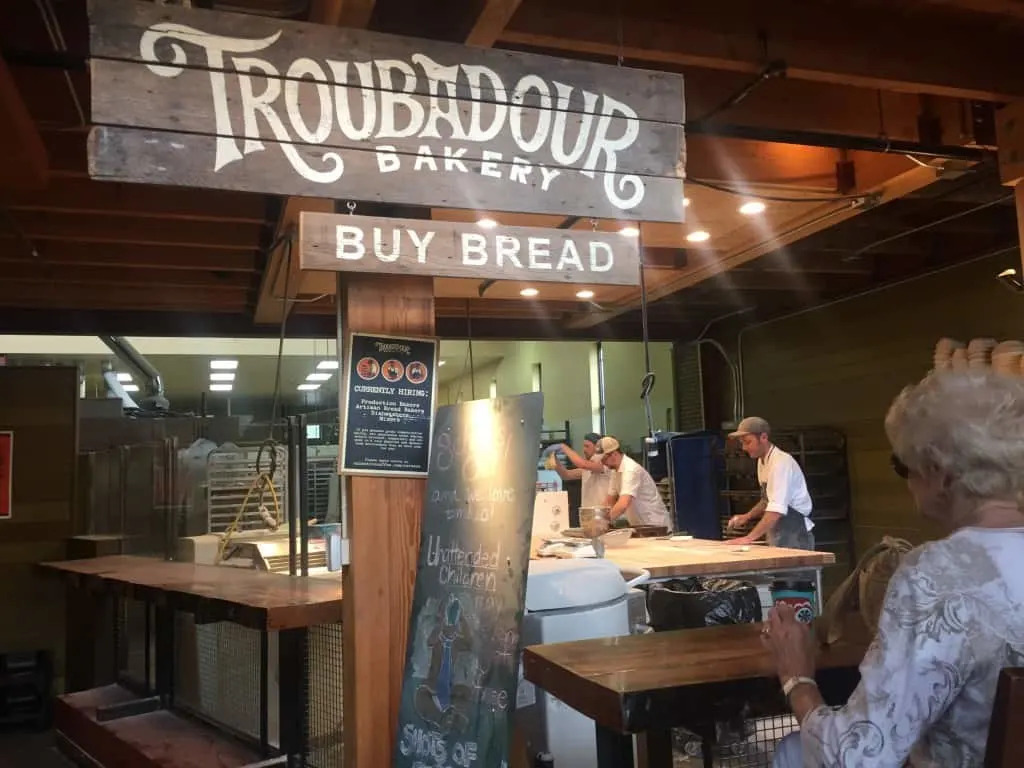
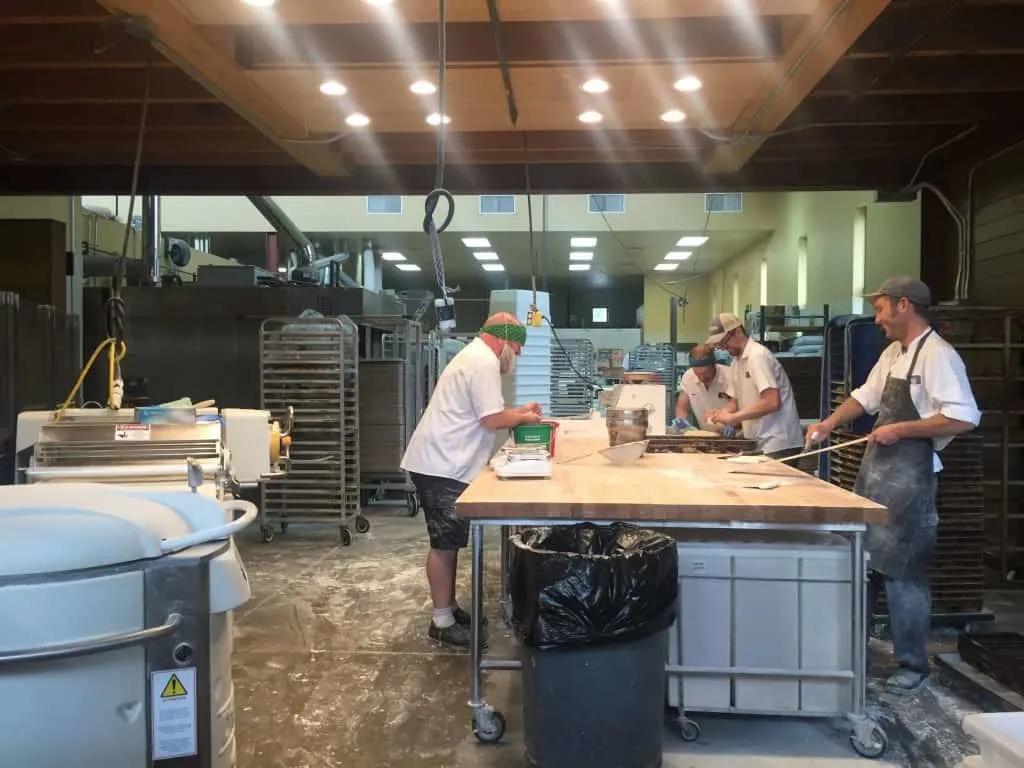
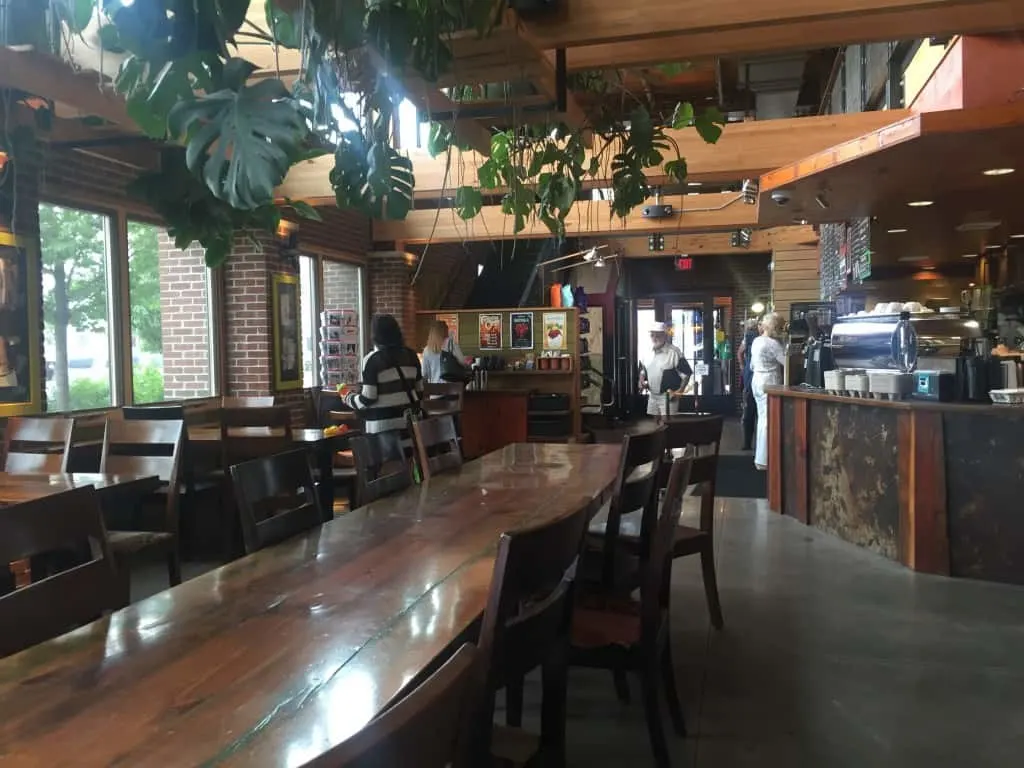
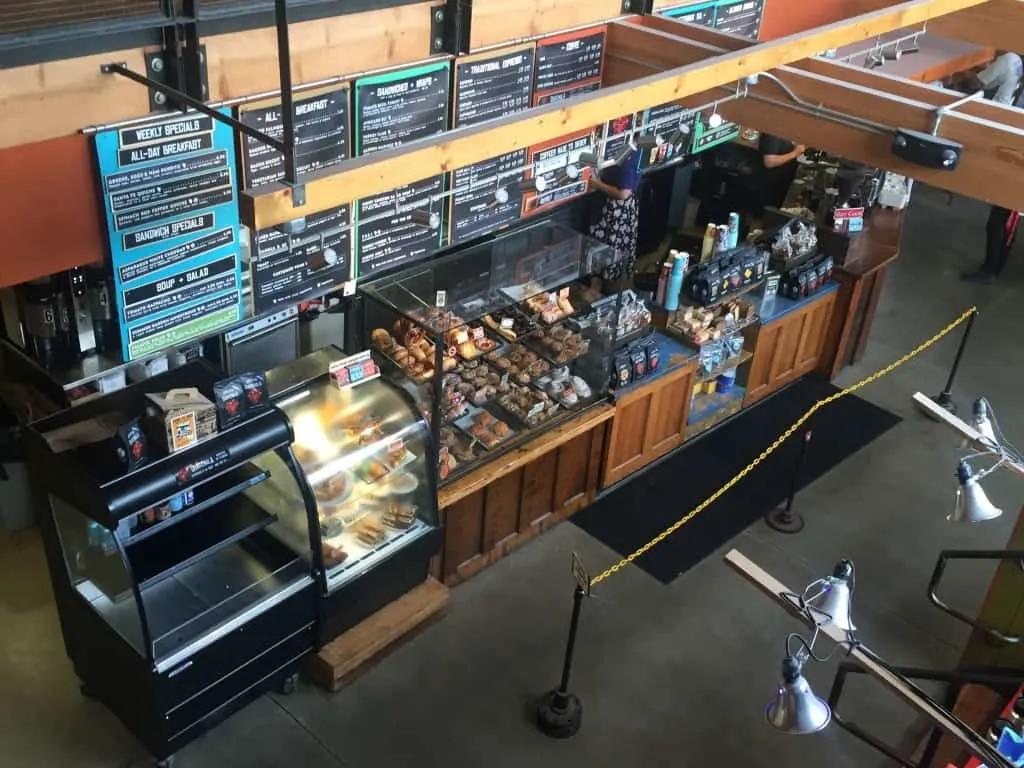

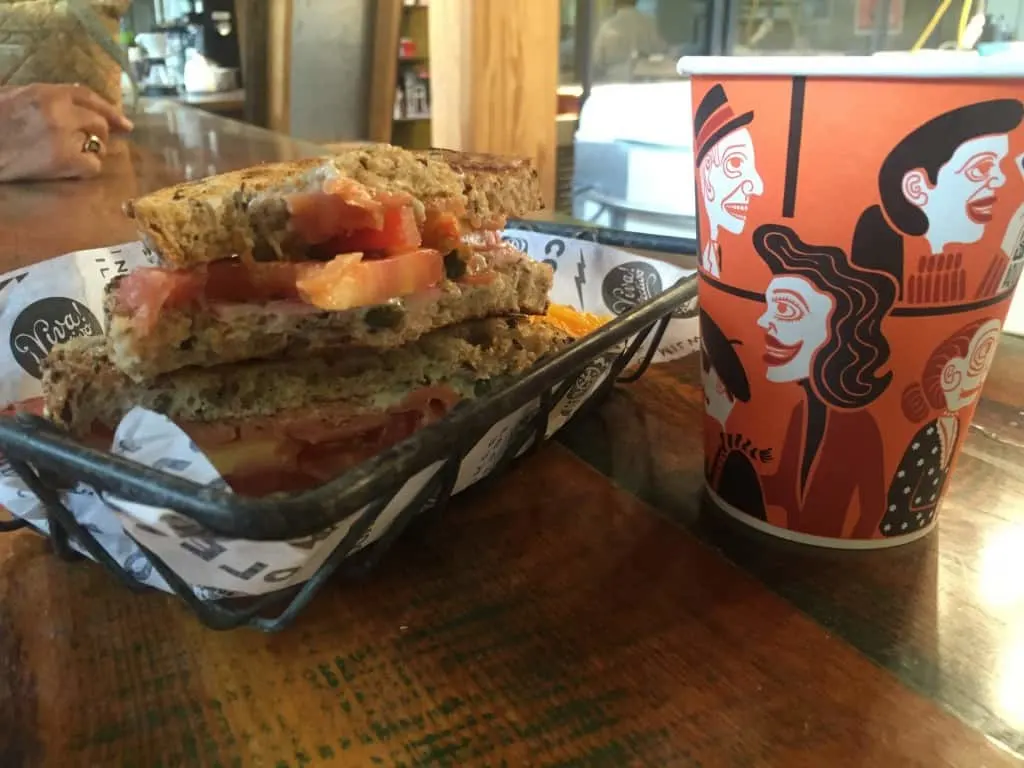

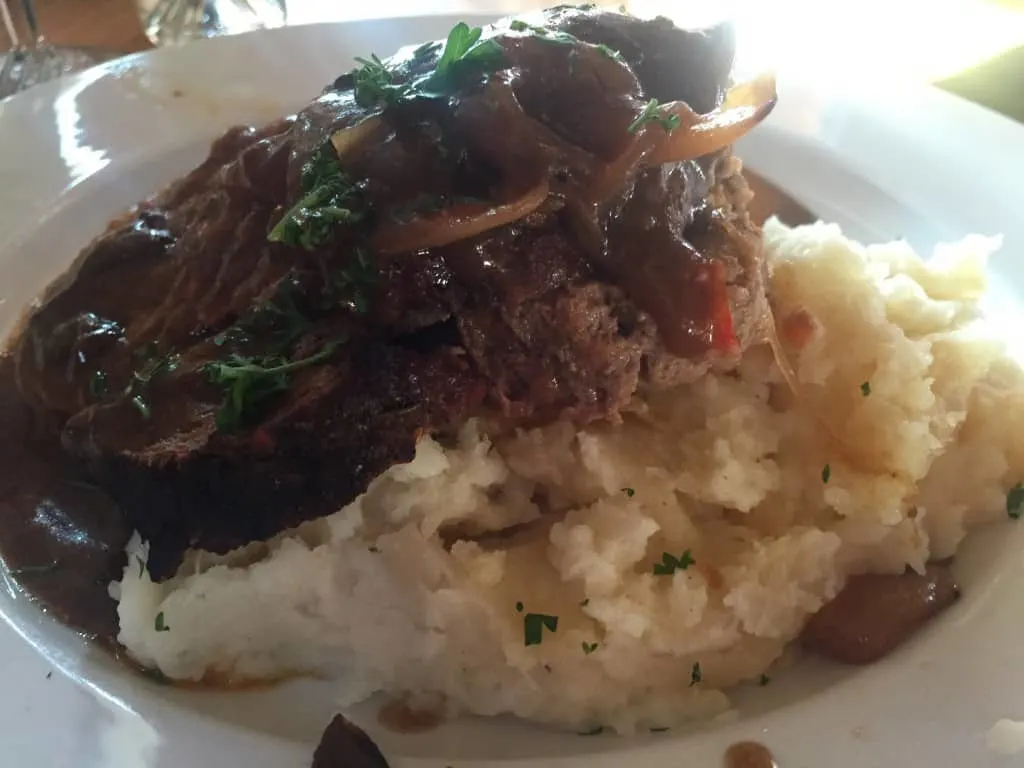
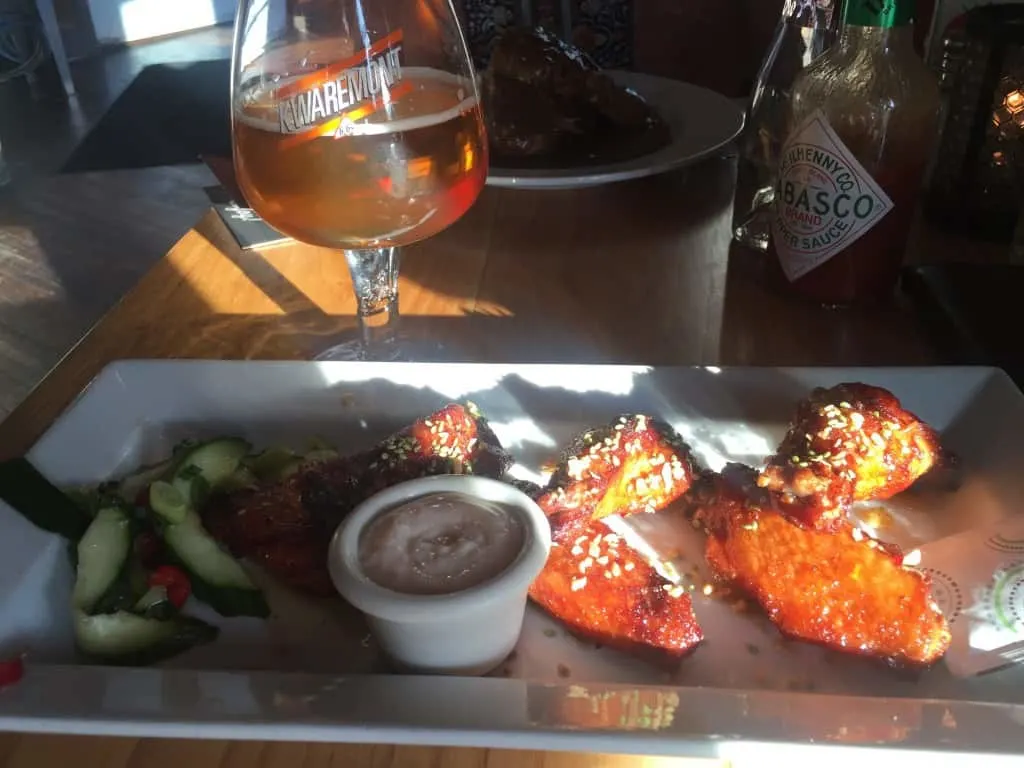
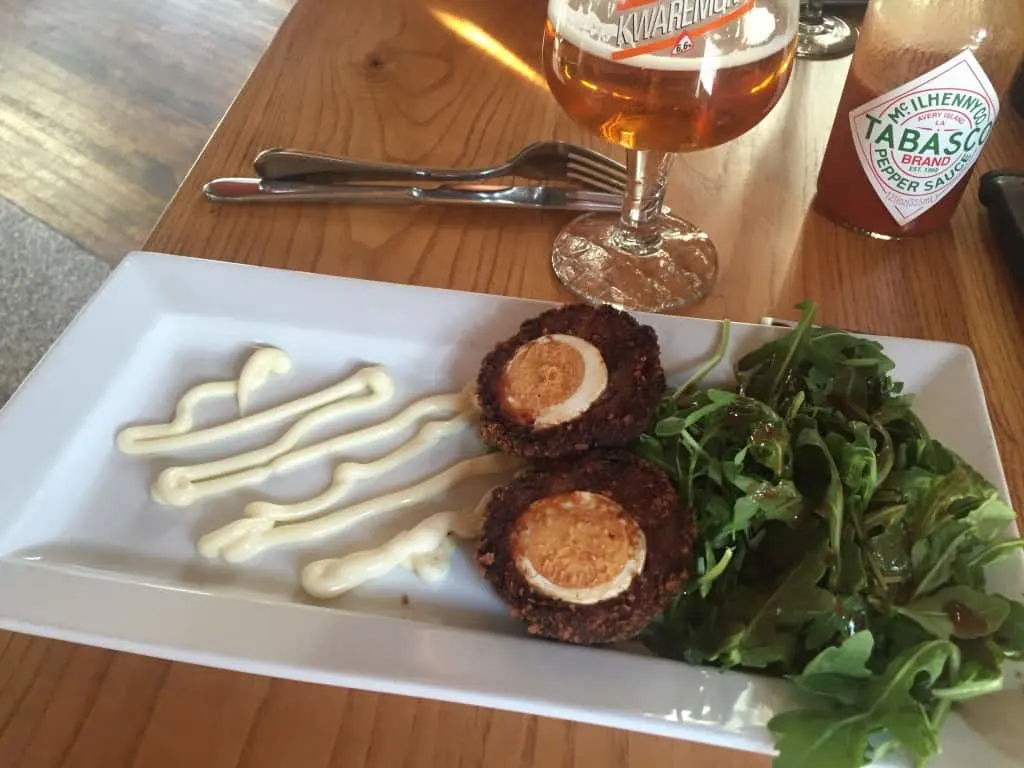
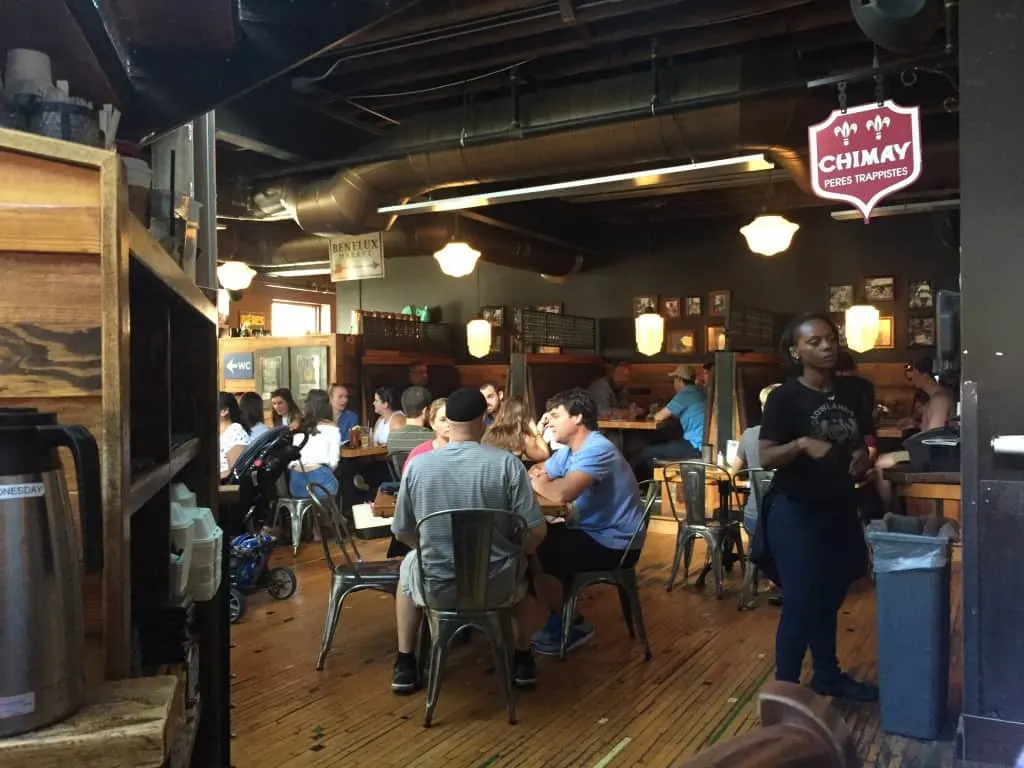

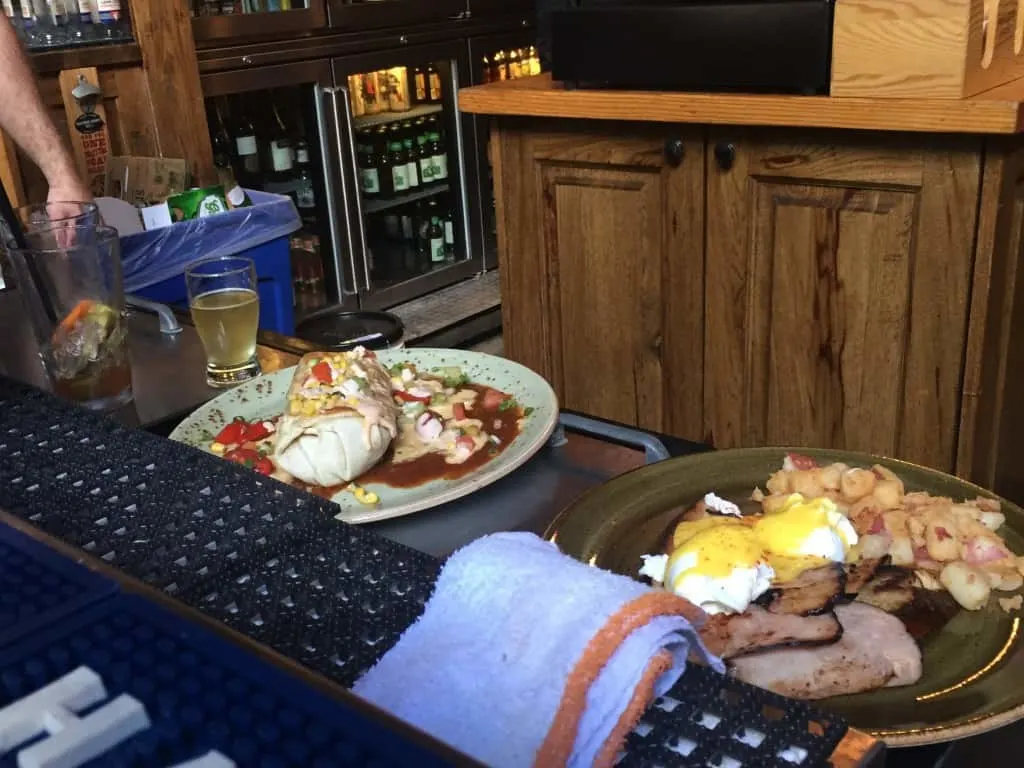
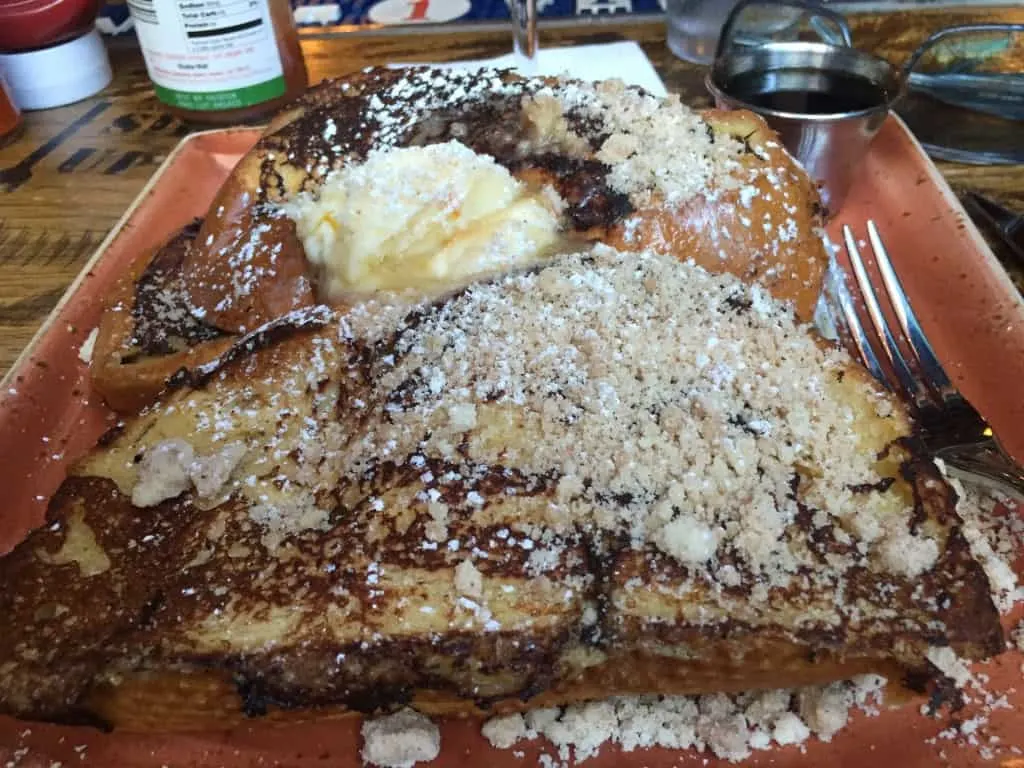
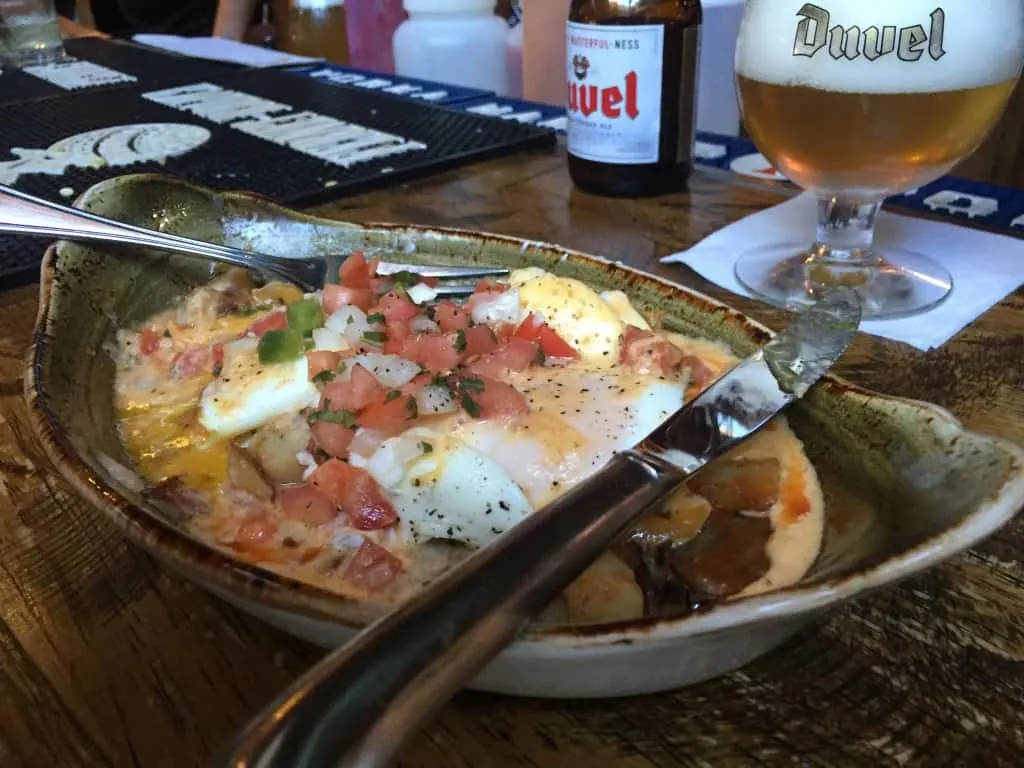
Irene S. Levine
Tuesday 16th of August 2016
Sounds like an interesting place to visit---more interesting that I would have imagined. Certainly many opportunities to sip and savor!
Sue Reddel
Sunday 14th of August 2016
Loved your article on Milwaukee Betsy. Like you we were surprised by the food choices that now exist in Milwaukee. We've been back several times and each time we discover new places that are delicious. I have to confess that I've often thought of moving there. It's very similar to Chicago but smaller, much easier to navigate and I just love the people there - so nice!
Betsy Wuebker
Monday 15th of August 2016
Hi Sue - Yes, Pete and I were in agreement that we could very comfortably live in Milwaukee. Very easy to get around and great neighborhoods and people.
Karen Warren
Tuesday 9th of August 2016
I'd heard of Milwaukee's beer industry but I didn't know anything of the town's history. It seems as if all that immigration has produced a really rich and varied culture. I'd love to visit and explore all those historic buildings (and try the food and beer as well of course).
Betsy Wuebker
Monday 15th of August 2016
Hi Karen - You'd be most interested, I think, in the Cream City brick industry and all the buildings which remain.
Donna Janke
Monday 8th of August 2016
Milwaukee sounds like a place I'd feel very comfortable in. Its immigrant history reminds me of my own city of Winnipeg. I like the mix of architectural styles. And there certainly appears to be a lot of choices to stave off hunger and thirst!
Betsy Wuebker
Monday 15th of August 2016
Hi Donna - You're right, a very similar history to that of Winnipeg. And yes, you won't leave Milwaukee hungry and thirsty!
Charles McCool
Monday 8th of August 2016
The high speed ferry sounds super cool. Was it a bumpy ride?
I did not know Miller was a German company. Very interesting.
Betsy Wuebker
Monday 15th of August 2016
Hi Charles - The ride was very smooth on the day we crossed. :)